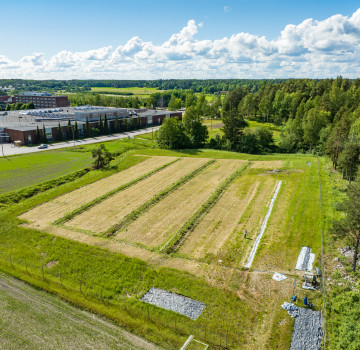Timeline
This timeline shares milestones in the project's implementation. Design limitations keep it from being as interactive as I would like, but if you use the "search" or "find on page" function of your browser, you can jump to locations and themes attached to each entry (separated by horizontal lines). For example, if you want to learn more about tree lines, you can search for "#TreeLines" and it will find the entries that have #TreeLines in the Location field. Likewise, if you want to follow a theme, you can search for example "#Analysis" and that will sort entries for the Theme field.
Tag list
Location tags: #WholeField, #Margins, #Alleys, #TreeLines, #OnSiteEvents, #World
Theme tags: #Analysis, #BedPreparation, #FieldDay, #Infrastructure, #Mulch, #Planting, #CashCrop, #CoverCrop, #Spraying, #Weeding, #Workshop, #Observation, #Biostimulant, #Spraying
15.06.2022 First Biostimulant Application
Once the project was approved we decided to spray a biostimulant of vermicompost extract, seaweed extract, and light nitrogen/potassium fertilizer onto the existing monoculture of grass.We were anticipating a normal summer with some rain, so the grass could have used a boost prior to strip tilling and adding a cover crop into the alleys. We mixed 150 liters of water from the pond to a ratio of ±0,5% vermicompost extract, 1.3% seaweed, and 0.6% 3-0-3 Aino liquid organic fertilizer.
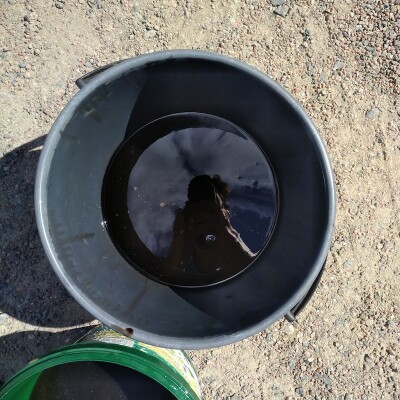
Location: #WholeField, #Margins, #Alleys
Theme: #Spraying, #Biostimulant
02.07.2022 Fence Up
Perhaps the most critical piece of infrastructure is the game fence at Lill-Nägels. With a small test site, each tree is necessary for the production of information about the system. In a successional agroforestry system, most plants will be grown from seed rather than planting stock. Without a perimeter fence, these young seedlings would simply become an appetizer for the large number of deer which live in the area. By this time the drought had set in and the mostly clay soil was so tough we needed to hire a professional fence builder with an auger to set the posts. (The fence has been provided by)
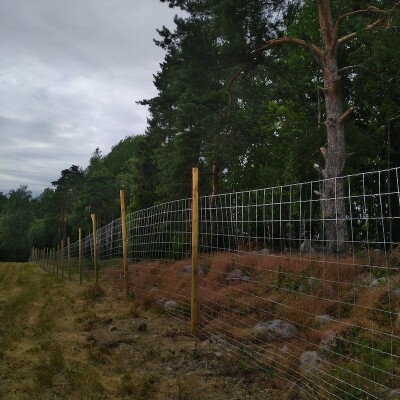
Location: #WholeField,
Theme: #Infrastructure
21.07.2022 Tree Line Preparation Begins
To get the most from an agroforestry system, precise bed preparation is necessary to ensure that the field is workable by machine. We hired Mats Wikner, a local farmer, to prepare the tree lines with basic tillage equipment. Mats brought his GPS-autosteering tractor to the site and carefully plugged in the parameters. Since the tillage implements are three meters wide, but we want two meter wide tree beds, some additional passes were needed to make sure everything was on target, but once things were settled, the tree lines were lined up with stunning accuracy.
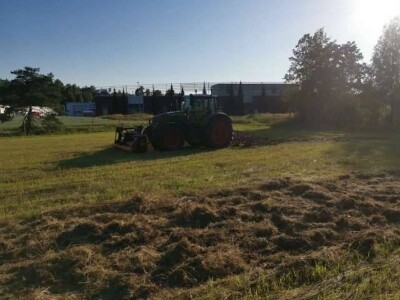 |
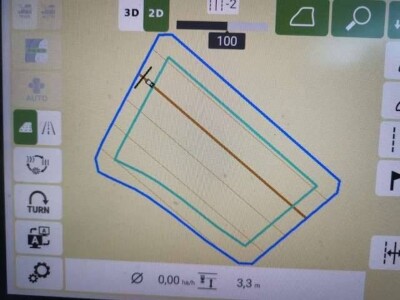 |
Location: #WholeField
Theme: #BedPreparation
03.08.2022 Soil Analysis: Digging Profiles
A large part of our project is intended to document how diverse agroecosystems improve soil conditions with minimal outside inputs. We are utilizing multiple methods to capture the soil's health along the way: soil laboratory analyses, soil microscopy, water infiltration tests, and direct observation of the soil profile. By combining different methods we have a much better picture of what is happening in the soil: everything is ultimately a reduction from the reality underground, but more information is better than less.
Over time we are looking to see how well the different methods approximate the soil's condition. Will they correlate with one another or will some methods better describe the situation than others?
Direct observation of the soil only requires time, a shovel, and some knowledge about what healthy soil can look like. Digging to half a meter's depth may not always be necessary, but when establishing the baseline it makes sense to invest the time.
For more information on the testing being undertaken, see the dedicated analysis section of the website
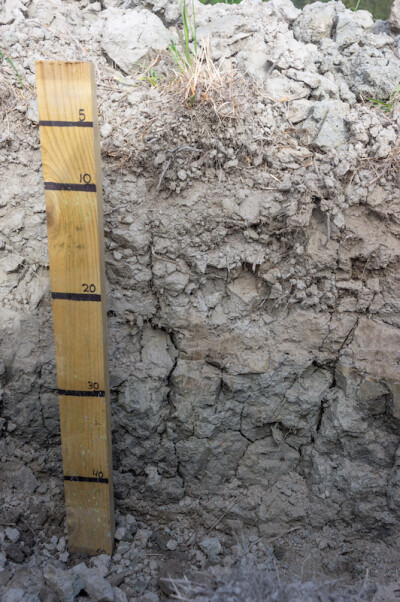
Location: #WholeField
Theme: #Analysis
12.08.2022 Compost: one application, multiple functions
A one-time addition of outside biomass in the form of composted horse manure was purchased and spread over the course of a few days. The front loader of a tractor is a great tool for the job if you do not have a dedicated compost spreader: the scoop is two meters wide and with some practice rather evenly sized piles can be laid out.
The compost is used as a mulch and not incorporated into the soil profile. This is important as we want this one-time input to perform multiple functions. As a mulch, it will protect the mineral soil profile underneath it from the elements (the sun, wind, rain). This will preserve soil moisture and moderate soil temperature- although the dark color of compost increases the surface temperature over the high albedo clay-based soil we have. Still, the textural "break" provided by the compost means that the soil is insulated and protected.
With a thin layer of compost- ideally from ±4cm deep as a one-time application, it is easier to perform mechanical weed control. Bladed weeding tools like colinear hoes will not become dull as quickly when working through soft compost. Mineral soils, on the other hand, are all heavier and more require more energy to cut through- working mineral soils also dulls the blades quickly. Fresh horse manure compost retains its structure and wraps around the blades, requiring cleaning, but the reduced efficiency is worth the cost. Namely because although multiple tillage passes were conducted to reduce the grasses vigor, many rhizomes were still alive. In order to heal themselves and begin growing again, they need to grow new leaves. With a mulch on top of them, the leaves need to grow longer than before and the new shoots are easier to cut with a blade.
Composted horse manure has a high carbon:nitrogen ratio and, although it will add nitrogen to the system, is not as powerful as a fertilizer as other forms of animal manure compost. With twelve meter alleys of perennial root systems digging down nearly one meter, nutrients leaching from the compost mulch can be captured in the system. In addition, the nutrients in the compost would be put to use by the first cash crop of garlic planted in the autumn.
Lastly, compost as a mulch kick starts the decomposition cycle by adding available nutrients as well as those bound more tightly to the carbon in the compost. The compost invariably carries along with it microbes and fungi which will continue to break the material down. Some of this carbon will be accumulated into the soil underneath as stable carbon, some will cycle through living organisms in the soil, and some of the carbon will of course go back to the atmosphere.
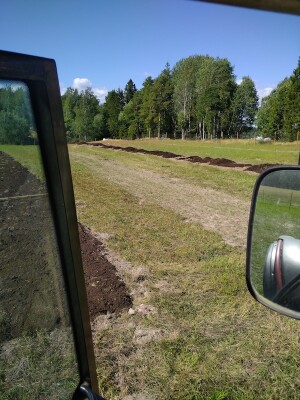 |
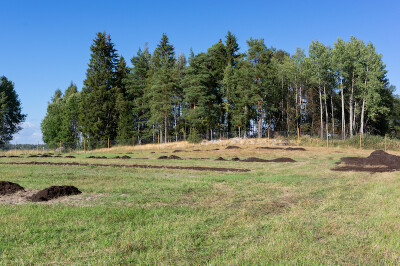 |
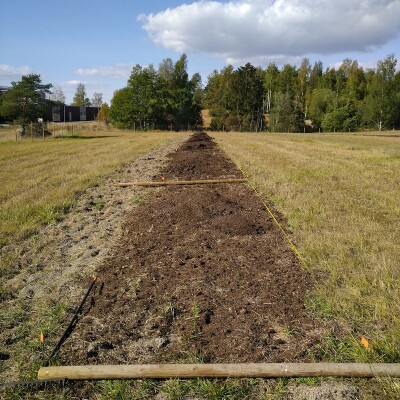 |
Location: #TreeLines
Theme: #BedPreparation #Mulch
19.08.2022 First Seeding: Diverse Covers and Biological Inoculants
The drought which took hold early in the summer continued to persist. Once most of the compost was spread as a mulch and it had been weeded mechanically a few times, I planted a highly diverse cover crop mixture into the tree lines. The planting was timed just ahead of a good forecast of rain. We decided that it was too try to attempt planting a cover crop in the alleys: without a mulch layer and the late time of year it would likely cost more than it returned. I still had a small reserve of compost that needed hauling with the tractor, but that small addition could be wait until the seeds were planted and simply added before germination- provided the rain actually came.
Why plant a cover crop?
A biodiverse cover crop can improve soil health and function by altering the soil structure and feeding soil microbes and fungi that, in turn, help the plants grow. Dirt turns into soil through biological activity powered by photosynthesis from diverse plants. Given the crop plan to add garlic in the autumn, one half of the tree line would be terminated and the other allowed to grow a while longer.
Overall, I combined between 28-30 different species of annuals and biennials from 8 plant families into a mixture intended to seed more than 2km. I used my Jang JP-1 vegetable seeder, which I have used for years for cover crop mixes, and planted drills about 20cm apart. The drills were offset from where I intended to plant the garlic: many of the species used are biennial and even if they were mowed multiple times and mechanically weeded in the autumn, many crowns would still persist. Offsetting the crowns means that they could be weakened by mechanical cultivation multiple times into the following spring to reduce competition with the garlic, if necessary.
The seeds were inoculated with in-house compost extracts (Johnson-Su, thermophilic compost, and vermicompost), a commercially available seaweed extract, as well as an endomycorrhizal product sold for seed coating.
The 8 plant families included: Poaceae, Brassicae, Boraginaceae, Polygonaceae, Fabaceae, Asteraceae, Linaceae, and Apiaceae. 1.2 kilograms of seed was planted.
Unfortunately, the rain did not materialize and the seeds remained dormant until much later in the year and were unable to benefit the system.
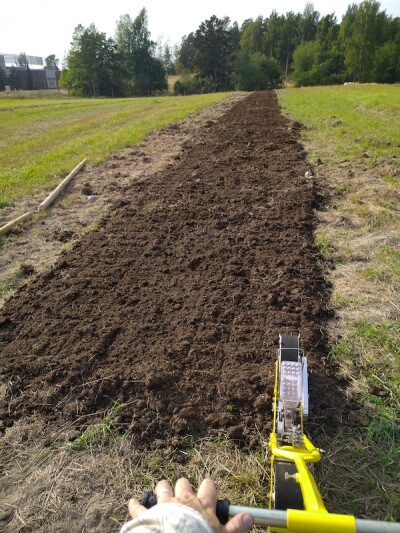 |
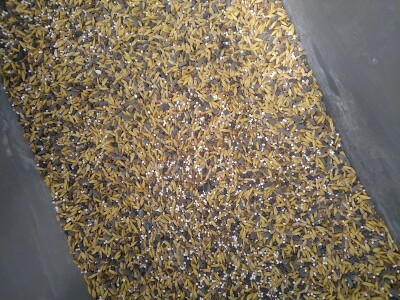 |
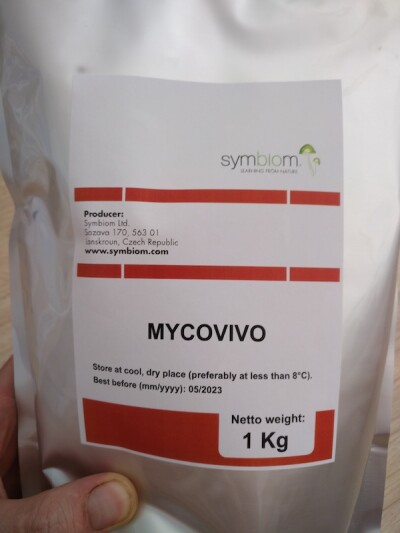 |
Location: #TreeLines
Theme: #Planting, #CoverCrop
23.08.2022 Soil Analysis: Laboratory and Microscopy
After the rush to implement the system, I was able to turn to collecting more data about the soil. Our budget for the first 6-month bootstrapping phase was sufficient to choose one sampling period and two zones. Starting in 2023 we intend to test the soil from four different soil and management zones three times each season. One of those testing periods will be in late summer, around mid-August, to capture a picture of the soil at the peak of photosynthesis.
The results of both the laboratory testing (conventional soil testing and Near Infrared) as well as the soil microscopy corroborated the observations made earlier from the soil profiles: very low soil organic matter (3.3-3.7%) and limited soil biological activity. They did, however, indicate large reserves of important nutrients that improvements to the biological functioning of the soil should make available.
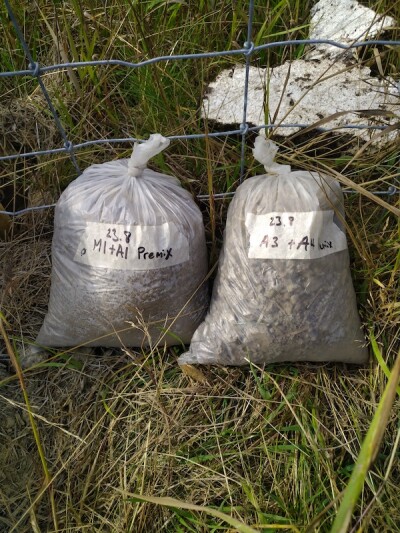
Location: #WholeField
Theme: #Analysis
20.09.2022 First Rain
The drought finally broke at the end of September. The seeds which had lain dormant for a month began to emerge from the compost. In addition, the rhizomes of the existing grass, began to grow. The expected growth pulse from the nutrients leaving the composted manure helped the grass more than the cover crop seeds.
This is in part because the rhizomes have a lot more energy to put into producing new leaves than the seeds do. In addition, by the end of September, our part of the world is just about to enter the "Persephone Period." The Persephone Period is a term used to describe the season with less than 10 hours of sunlight. Perennial grasses are well adapted to growing in adverse conditions, while most of the cover crops I used need the heat and light of the summer months to grow well.
As farm trials have indicated it takes a cover crop at least 4 weeks of growth to change the soil's fertility and structure to an appreciable degree. With germination just beginning at the end of the growing season, the little plants would struggle to provide any aid to the soil before garlic was to be planted.
Therefore I decided the best thing to do would be to weed the entirety of the tree lines mechanically for the rest of the season.
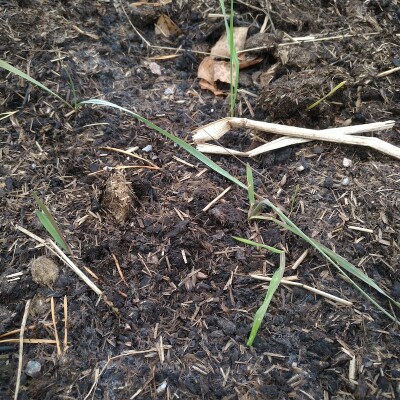 |
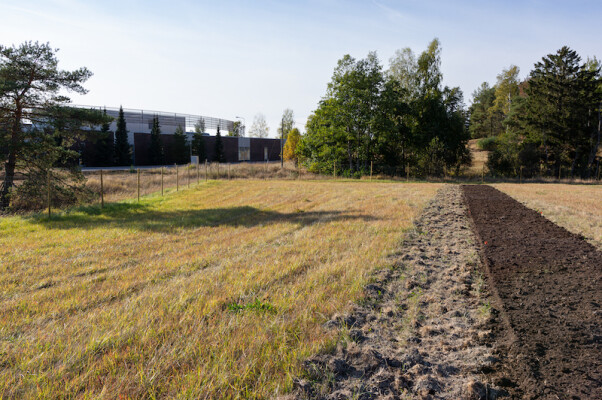 |
Location: #TreeLines
Theme: #Weeding, #CoverCrop
27.09.2022 Managing Weeds
For our project we have decided to forego the use of chemical biocides and are opting for the implementation of small scale market gardening techniques to manage weeds in the tree lines.
This is in part because we want to utilize existing resources (tools, knowledge, experience) and because of the adverse effects of agrichemicals on soil biota.
Weeding with sharp colinear hoes takes time. An extremely thorough weeding (3 passes per square meter) the entire area takes about 3.5 hours. Quicker, but still sufficient, full-system weedings took about 2 hours. All told, twelve hours were spent weeding the entire tree line system (682m2) to varying degrees from the end of August through mid-November.
Ensuring that the beds are as close to zero-photosynthesis for weeds as possible is important if you want to reduce weeding in the future. It is possible to reduce the number of weeding events to only three or four per growing season with conscious effort and no-till/no-dig systems that have a compost mulch layer.
Creating systems with less weed pressure opens opportunities to fill niches that the weeds would otherwise occupy with species with a purpose: providing an economic return or supporting the soil and agroecosystem development upon which the economic crops (cash crops) depend.
What this means is that every single weeding session is an investment in the future of the system. Tracking the time invested into each part of the system allows us to make calculations regarding the cost of the methods and create a better "chain of production" for each target cash crop as well as the whole system cost.
There are other ways to handle weeds, of course, and if you are interested to hear more ideas, you can see the Alternative Choices timeline section.
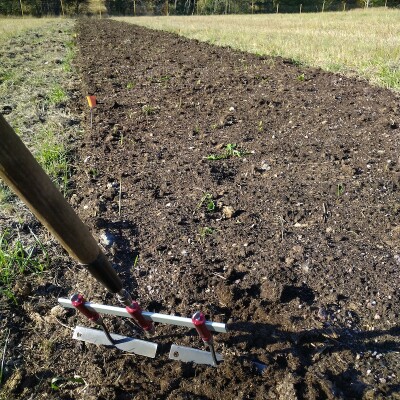 |
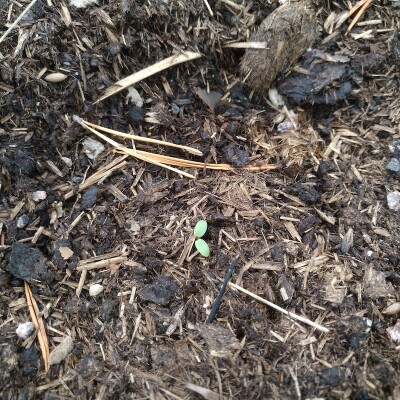 |
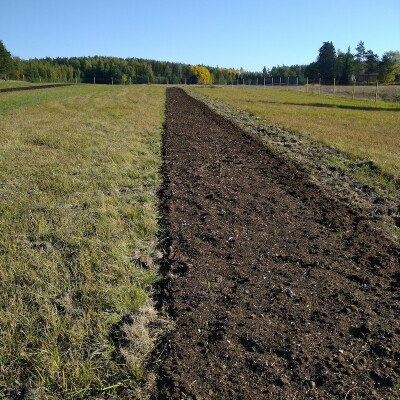 |
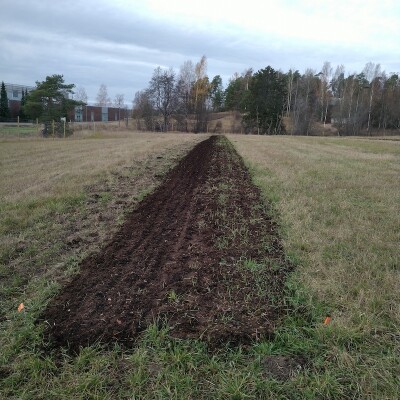 |
Location: #TreeLines
Theme: #CoverCrop
07.10.2022 Field Day
The very best way to engage with other people and experience a place is to be there. The Lill-Nägels Agroforestry project has a lot of moving parts, many of which remain novel to even the most seasoned farmer. These elements are not so easily captured in executive summaries or short social media posts. And there are always a million excellent questions that only another person would think to ask!
Although during my time as a farmer I hosted farm tours and was used to explaining my systems to visitors and supporters, I was rather nervous for this Field Day. For one thing, the drought had only just broke and despite my best efforts to get something planted, the site looked much as it had in August: a fenced field with long strips of compost laid out in it. The cover crop I had battled heat exhaustion to plant over a month earlier remained in the ground as dormant seeds. The grass in the margins and alleys had not grown at all after its first mowing in early July. What a stark contrast to my old farm where we always had lush gardens and progress because of irrigation! How do you get anyone interested to take a look at compost?
So to prepare I produced a program for the day that would introduce the project's conceptual background, explain the site's key features, and even attempt to model the stratification of cash crops in an example tree line. If I didn't have my diverse cover crop to help me do the talking, I'd have to make the best of what I had.
Fortunately my concerns were not on the minds of our steering committee: all in attendance knows that farmers don't control the weather and, more importantly, everyone has been involved in pilot projects long enough to know just how much effort a thing like this takes. My own fears about the project not being as far along as I would have liked also faded quickly once we were altogether.
Freshly brewed coffee, ripe apples from Rikard's orchard, and some Finnish pastries did their job helping to break the ice. For about three hours we went back and forth about agroforestry, the potential and drawbacks, and the special opportunity that Jordfonden, Novia, and Rikard's farm had come together to create: namely to test many of the claims about regenerative agriculture. Not to test them in a highly structured, rigid managment system, but rather with adaptive management and a team of people who think this might actually work.
After all, the first six month project's intent was to do everything possible to get the project ready for the first full growing season of 2023. Even if the weather had cooperated, a six month agroforestry project was not going to have anything more than a few months growth to show and tell. What mattered most was getting the team together in the field where we could bond over soil and the commitment we had made to try something radical.
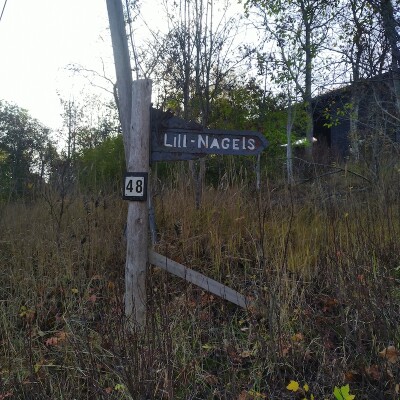 |
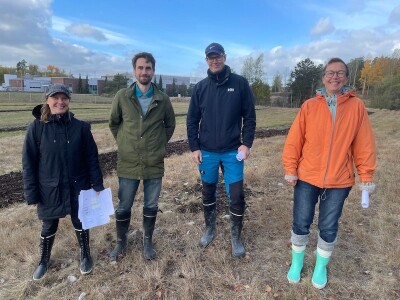 |
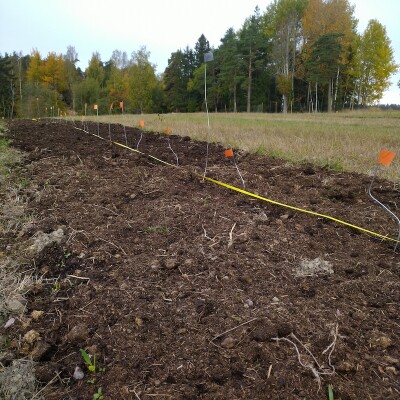 |
Location: #WholeField, #OnSite#Events
Theme: #FieldDay
10.10.2022 Visiting Denmark: Syntropic Agriculture with Josipa and Ernst
In mid-October I had the once in a lifetime opportunity to visit Denmark for three days and study in a small group setting with Ernst Götsch at Josipa Bićanić's farm. Ernst Götsch is a globally esteemed farmer famous for coining the phrase "syntropic agriculture" to describe systems that accumulate energy and increase life rather as opposed to most systems which do the opposite. He is quite famous for his agroforestry systems which put people back into the ecosystem as a functional partner. High biodiversity and an attention to detail not typically associated with farming are just two hallmarks of his philosophy.
The most important lesson I learned from my time in Denmark was that to be successful with process based agriculture one needed to be willing to try. I was heartened during his public talk about his work that the project at Lill-Nägels is on a good track with our adaptive management and systems approach. Even if he would certainly do things differently, the point is to get started and farm "information."
A referenced article about my trip is available through Novia by clicking this link. For more publications and reports visit this section of the LillNAP site.
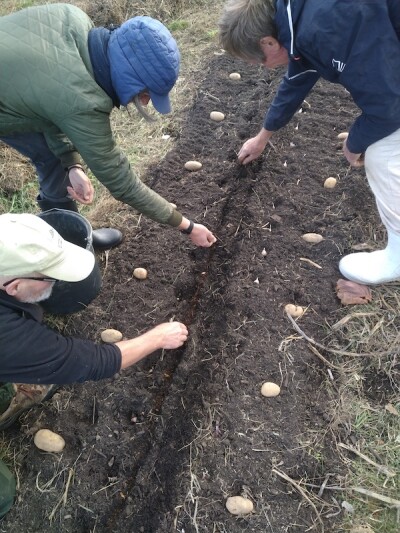 |
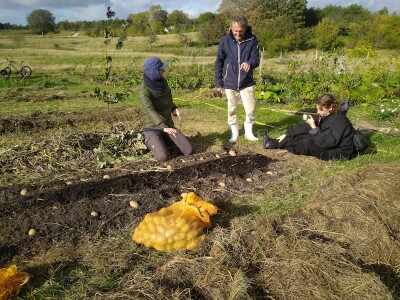 |
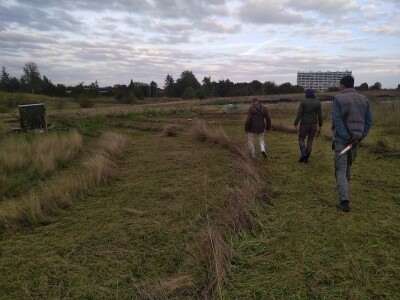 |
Location: #World
Theme: #Workshop
31.10.2022 Garlic: The First Cash Crop
One key aspect of the Lill-Nägels Agroforestry Project is that we are addressing the Achilles' Heel of agroforestry: the long return on investment. Many farmers are keen on the benefits of agroforestry, but the way it is typically implemented means that the farm must bear, year after year, plenty of costs (expenses) before revenue begins to materialize.
Successional agroforestry, in part, means including cash crops at each stage of the system's development and managing the system to benefit those crops while accumulating resources for the next species in line.
In our case we are starting the ball rolling with garlic. Garlic has a number of advantages over other annual crops for this kind of system such as its ease to manage and high value.
In all, just over 46 kilograms of planting garlic were put in the ground over the course of 9.5 hours. Planting time would likely have been quicker had I not been ill at the time. The seed garlic was divided into sets of 200 cloves by size and weighed. Each set of garlic was tracked to a location in the field so we can compare planting weights and densities to yield. Given that this is the first cash crop in the system and we were unable, due to drought, to improve soil conditions through living plant roots and build the foundation of soil microbiology, the yield will likely vary quite a lot.
I'm projecting anywhere from 372-626 kilograms of fresh garlic harvested next July. This garlic will form the basis of the first round of the novel CSA program we are developing for the system.
Knowing how much garlic of what size clove was planted in each part of the field will also allow us to know how parts of the field compare to one another: if one area with the same weight and density greatly outperforms (or the opposite) we will have cause to investigate the soil and see if there is a clear reason for the difference.
All of the garlic was inoculated with biostimulants made from Johnson-Su compost slurry, seaweed extract, and endomycorrhizal inoculant. The plants should already begin to establish a biodiverse rhizosphere as the cloves strike before winter. In that way, winter garlic will serve as an base for soil biodiversity to expand in spring as soon as conditions allow.
If you are interested to read more, you can see the article on garlic integration here.
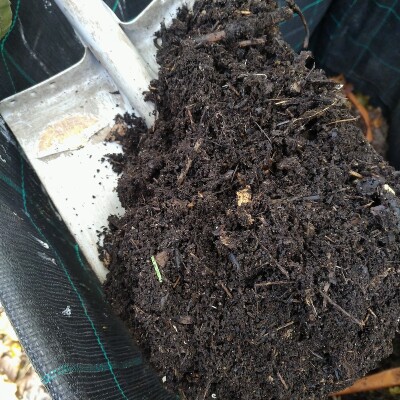 |
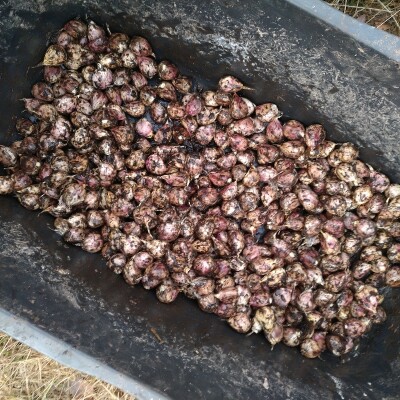 |
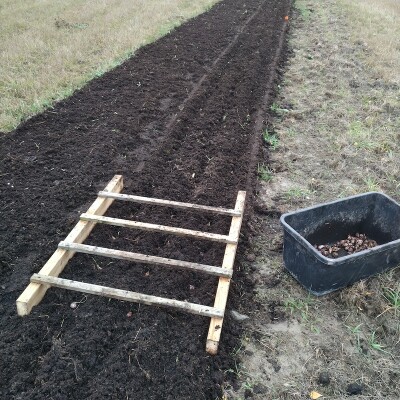 |
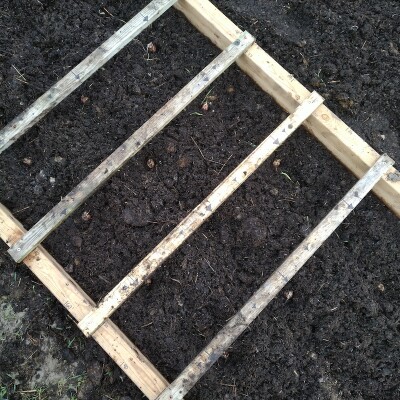 |
Location: #TreeLines
Theme: #Planting, #CashCrop
12.11.2022 Seed Bank Deposit
One of the most cost effective ways to establish a highly diverse agroforestry system is to plant seeds. Bare root stock and even cuttings cost a lot more on a per unit basis. Although nursery stock will bear sooner and provide control over the cultivars planted, seeds have a number of other benefits than simply cost.
Over the course of a couple afternoons, we planted about 320 meters of seeds belonging to about 15 different species. These ranged from oaks and ash to rhubarb and black elderberry. Some of these species are early succession species- meaning they should thrive in the open site conditions with full sun and poor soil. Others will either not grow at all and wait until better conditions, or grow more slowly while the early succession species are managed to help them along. All of these species, though, are intended to serve the whole: that is, even the mighty oaks are not intended to grow to their full height. Rather, they will each be managed in context to provide biomass and channel solar energy to the soil community through diverse root exudates and plant-specific associates. We aren't planting a forest, but rather planting an ecosystem in miniature.
As with the garlic, the seeds had been carefully sorted into bags that would be planted into 20 meter blocks. This way I could more easily ration out the seeds and have a rough to clear idea regarding how many seeds of each species were going to each place in the system.
Since the site has a plan, we skipped the locations where we will plant bare root stock cash crop trees in 2023 and put the seeds in one single furrow as a mix. Once the seeds were situated, we applied a compost extract slurry that also contained seaweed extract, endomycorrhizal inoculant, and for the first time, a commercially available ectomycorrhizal inoculant.
Ectomycorrhizal fungi are more well known to people because many of the mushrooms we pick in the forest are those that are growing in associations with trees: chanterelles, boletes, even truffles. Sadly, none of those were in our mix- instead the inoculant is filled with species that are more widely adaptable. Even if the mix does not include gastronomically valuable fungi, the species included should form associations with the forest species and help them thrive.
All told, perhaps 3000-4000 seeds were planted. While this may sound like a lot, many of the seeds will never germinate at all. Of those that do, many will be cut out of the system and returned as mulch within a few years. It is better to have plants to select from to serve a purpose than to wish you had them years later.
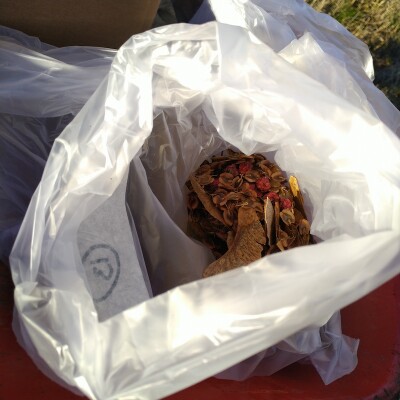 |
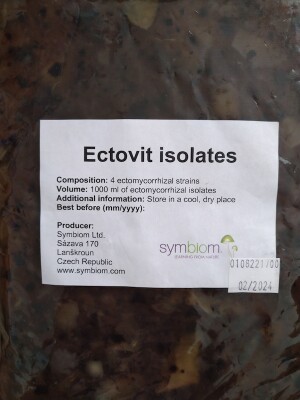 |
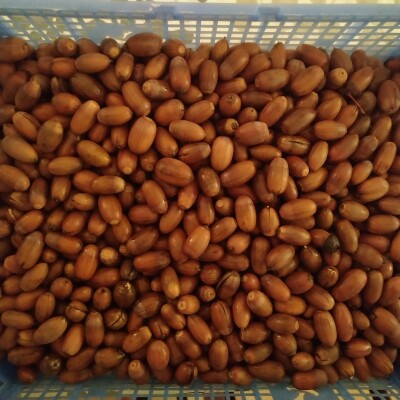 |
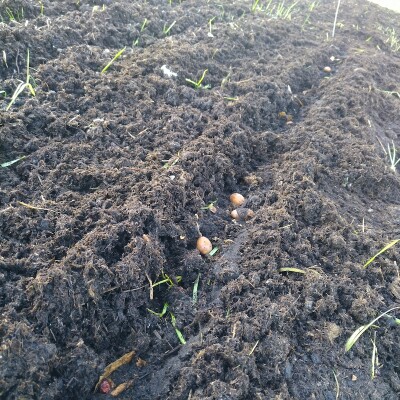 |
Location: #TreeLines
Theme: #Planting, #CoverCrop
18.03.2023 Spring Equilux
Finland is slowly emerging from our long winter. I visited the site on the 18th of March when we have 12 hours of day and 12 hours of night: not exactly the equinox, but the equilux.
The first patches of snow were beginning to melt and I could see that the garlic which has survived is already sending its first shoots out. Other garlic bulbs weren't so lucky and were heaved too far out of the compost to make it. I knew that this might be an issue, but given the extremely delayed delivery of our seed garlic (the logistics company "lost" our packages for almost a month), I didn't have the time to dig each clove as deeply as normal.
It will still be a few weeks before the snow melts enough to take a full count of the garlic, but it will happen at some point. Once we have a census it will be possible to launch the website for the CSA and begin taking orders.
Here's to spring arriving by May and the cold being kept at bay until October or November!
Location: #WholeField, #Margins, #Alleys, #TreeLines
Theme: #Observation
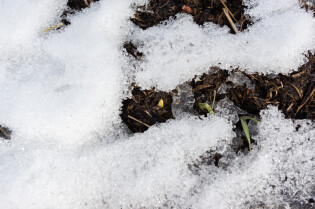 |
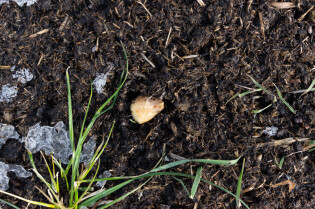 |
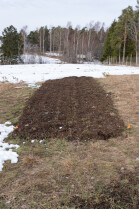 |
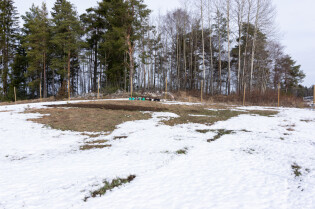 |
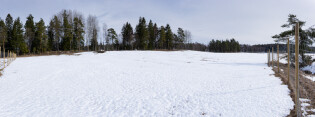 |
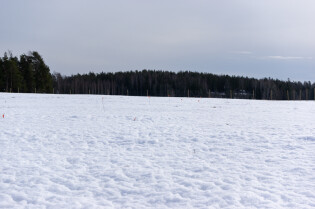 |
 |
23.03.2023 Novia Spring Research Seminar: Successional Agroforestry to Bioremediate Degraded Soil
I participated in Novia University of Applied Sciences' Spring Research Seminar program. We decided to record the presentation and make it publicly available.
The topic was a mouthful- admittedly- "Successional Agroforestry to Bioremediate Degraded Soil: The Lill-Nägels Agroforestry Pilot Project (LillNAP)."
I had thirty minutes to share (one of) the problems we are attempting to address with our project, where we have looked to for solutions, and a bit of how we draw from the agroecological toolkit in our project to address those issues. With the time pressure I needed to keep things at a general level while still having a line of reasoning that draws from the start through to the finish line.
Afterwards I had another half hour to answer questions. This was very good because I never know what people want to hear, so having folks ask questions is a great way to go a little bit deeper where it is wanted!
If you would like to watch the recording, it is available here on YouTube (External Link to Google/YouTube).
I've added chapters to help you navigate not only the talk portion, but also tried to get the right timestamp for each question.
This was one of the first times in a very long while that I had a live audience and unfortunately the camera didn't follow me, so it is mostly my voice and some of those in physical attendance.
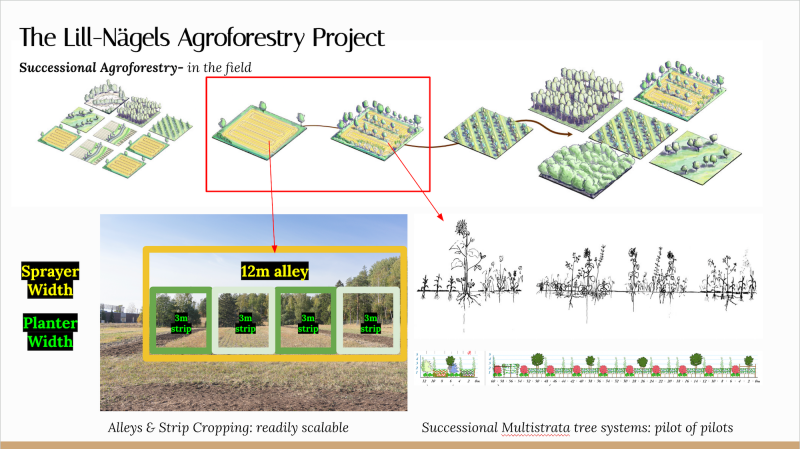
Location: #World
Theme: #Seminar, #Presentation
05.04.2023 Project Poster for Novia RDI Days
In late winter, Novia hosted their Research and Development Days in Turku, Finland. I made a poster which uses assets created last winter to illustrate, in a simple manner, the differences between a forested ecosystem, conventional annual-based agriculture, and agroforestry systems in relation to the environment and Baltic Sea.
Novia's work is oriented towards coastal regions and agroforestry can play a part in reducing negative runoff and other impacts on our aquatic ecosystems. It may not always play this role, but it has the potential to do so given the array of different kinds of agroforestry that can be deployed across farms.
In the interest of keeping the size of this website smaller, the poster has been reduced in size; if you would like to have a high resolution copy please send me an email.
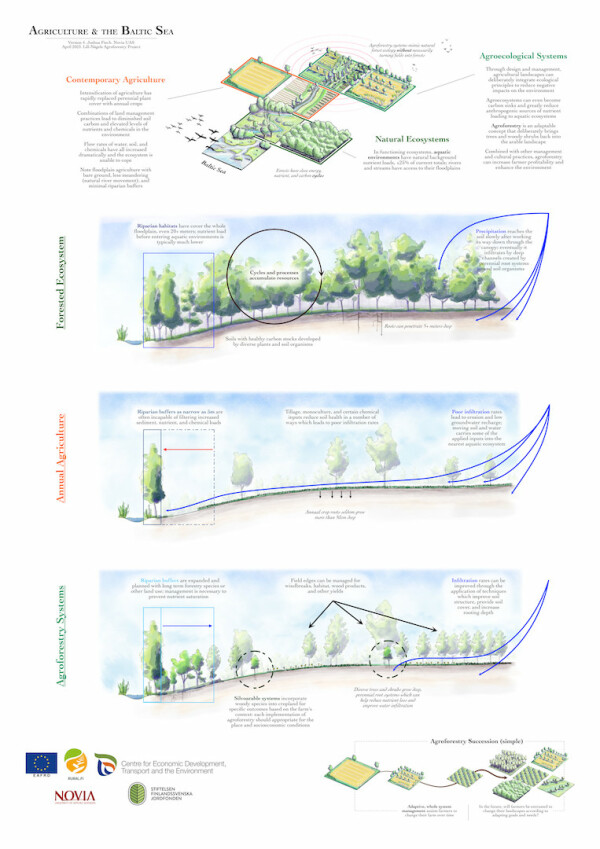
Location: #World
Theme: #Presentation
13.04.2023 Weeding Begins
It is important to begin clearing weeds away from crops as early as possible. Weeding is a topic that is discussed elsewhere on this site, including in the "Alternative Choices" section where I outline a few different approaches to starting your system so that you can reduce or even eliminate some of this work (Step 3).
When weeding, I had to avoid the center where we were waiting for trees and other perennial seeds to emerge (see the maple and rhubarb coming), so only the two 75cm edges were weeded. In total it took 185 minutes (79 for the space without garlic, 106 for with) for ±561m2. This wasn't a complete weeding in the area with the garlic because some are still emerging and you have to go a little slow to avoid damage. Square meters/minute should increase as the garlic grows larger and we can weed with more confidence. At this scale, manual weeding is still commercially viable.
Potential implements for mechanizing this work will be discussed elsewhere on the website, typically in the "Alternative Choices" section.
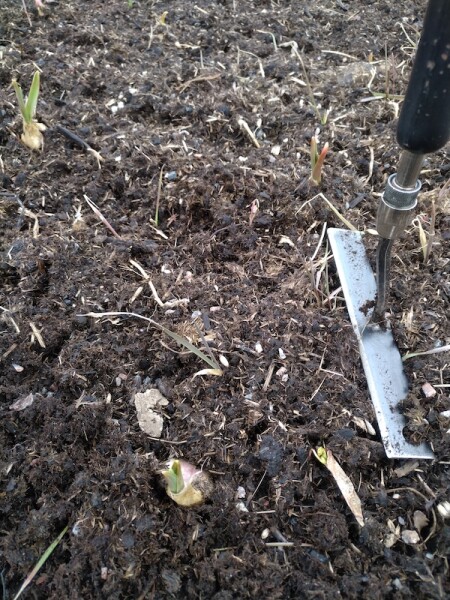 |
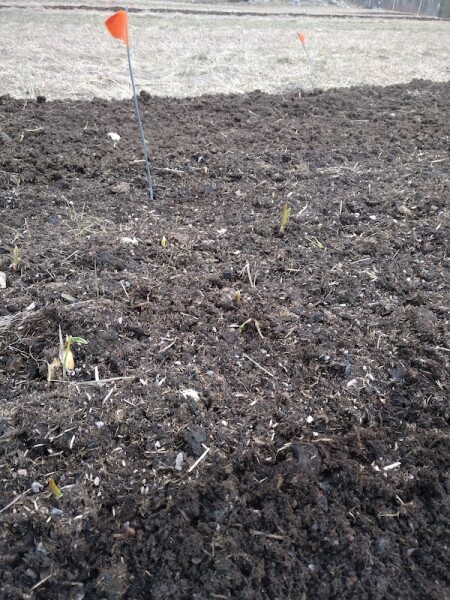 |
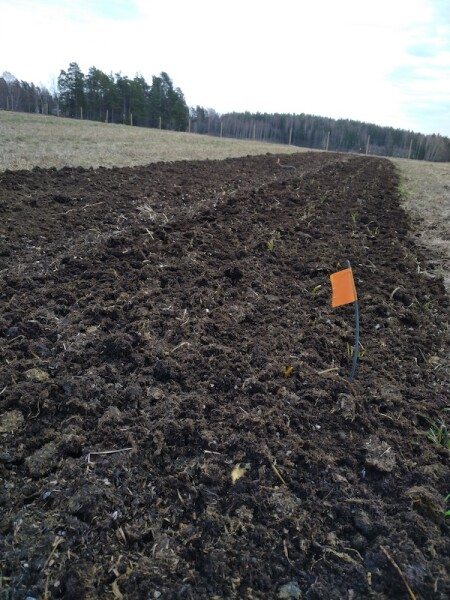 |
Location: #TreeLines
Theme: #Weeding, #CashCrop
18 - 26.04.2023 Propagation Material Collection
In late April, I visited an older Novia project at Västankvarn Gård to collect cuttings from currants and honey berries, with the hope of also getting some rhubarb crowns. I was able to collect quite a few stems, but needed to be careful with the rhubarb which had a bit of ant issues. Not wanting to bring those to the new site, I stuck with stems.
Later, I visited my old farm in order to dig up rhubarb and take black elderberry cuttings.
Unfortuntately my green thumb has really not worked out this year between moving locations and not having a dedicated nursery, so only the rhubarb wound up working as that was divided and put into the field. Amazingly, about 4 large crowns were divided such that they provided enough planting material for all except Tree Line 1 (which is special) and about 10 spots in T4! That amounts to over 100 "new" garlic plants from just a few parent crowns.
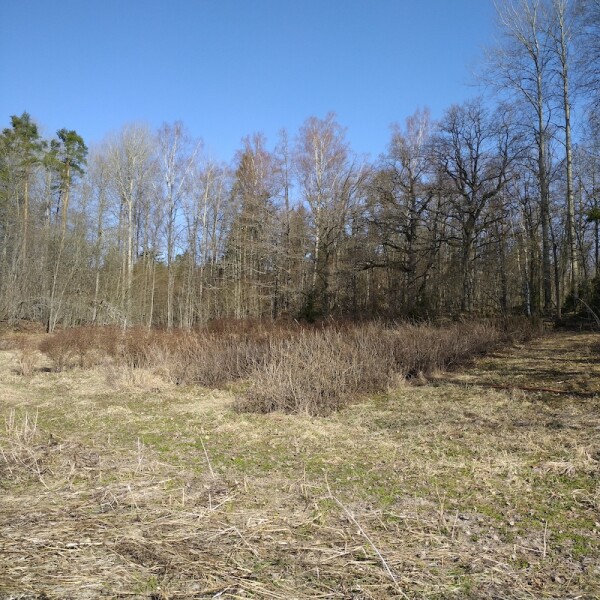 |
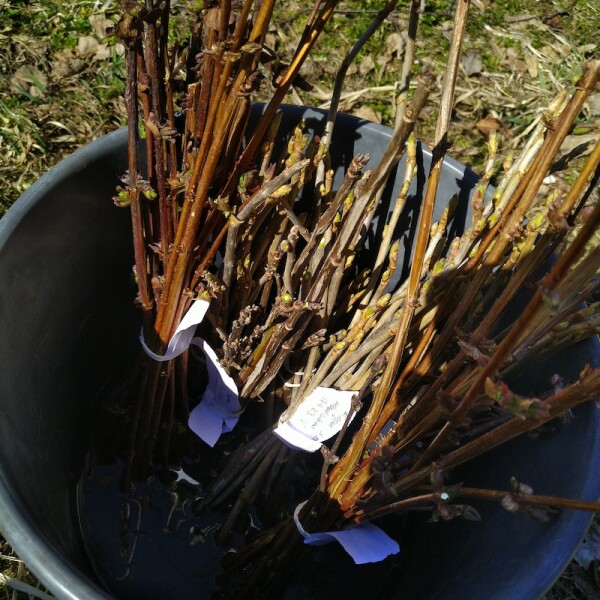 |
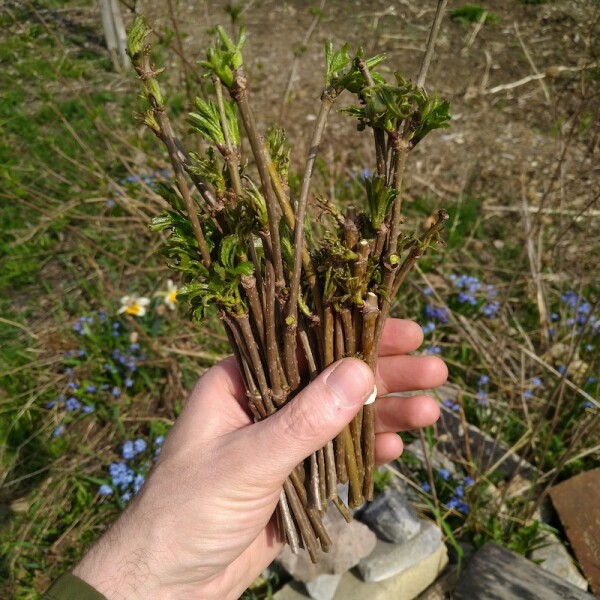 |
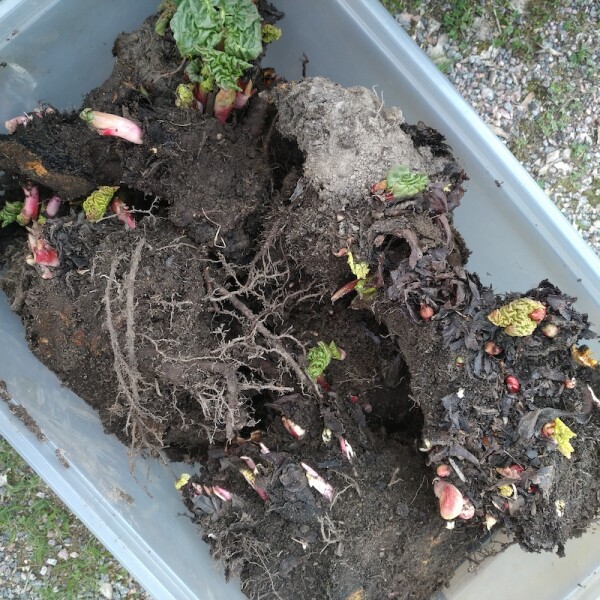 |
Location: #World
Theme: #Planting, #CashCrop, #Planting
27.04.2023 Willow and Fruit Tree Arrival
This was a big day for as both the large number of willows (60*1-2m whips, 225*25cm cuttings) and all of the fruit trees came over the course of a few hours. We purchased 16 sweet cherries, 15 pears, 12 plums, and six apples. Later, a few other trees and shrubs would be brought from my old farm and the grapes we had planned would come.
The willows were immediately placed into a large bucket of water (filled from the stream) and the fruit trees brought to the apple storage room at Rikard's farm, where the cool and steady temperature, plus lack of sunlight, would help keep the bare root trees dormant.
The trees joined a steadily growing number of planting material on site!
I should note that the weather at this point was still quite cold with daily minimums below or just above freezing and the wet-grass bulb temperatures recorded nearby staying quite below freezing. Without a covered greenhouse to moderate temperatures, it is quite surprising how well these plants survived.
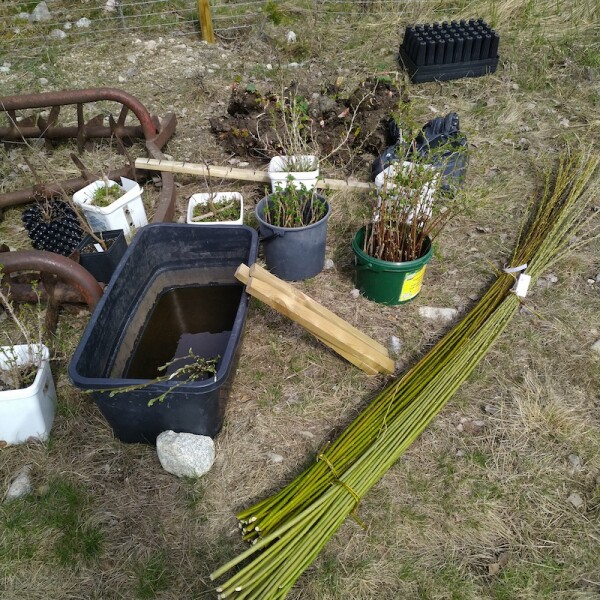 |
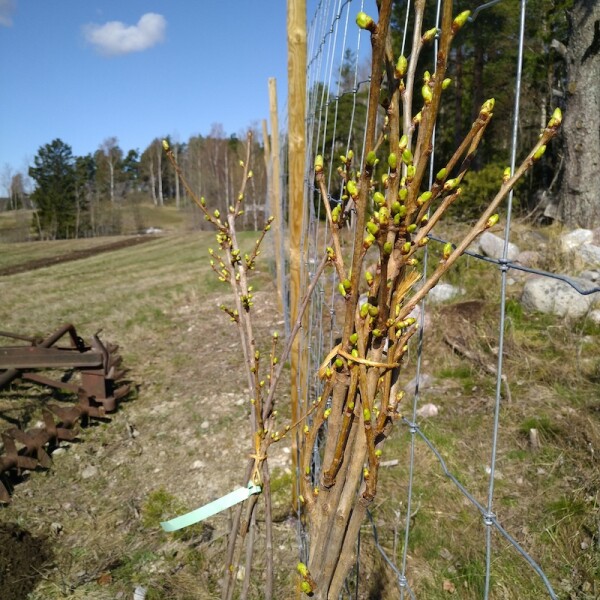 |
Location: #TreeLines
Theme: #Planting
01.05.2023 - 08.05.2023 Purchased Fruit Tree Planting
Planting this many fruit trees into soil which had not been improved at all by cover cropping (see last year's drought timeline!) meant that I would be digging into some really heavy clay soil. This would take time, so at on the first day I brought all the bare root trees to the field and started soaking them in water that I had added seaweed and compost extract to. The bare roots would take up the water, small quantities of nutrients, as well as the plant-growth compounds found in both of these ingredients. Perhaps the seaweed would even lend some cold-weather tolerance to the trees. Only after all of the holes were dug, hours later, would I begin to plant.
For preparing the planting holes, I followed the advice given to us by Ernst Götsch last autumn in Denmark:
- The first thing I did was to carefully mark out the position of each tree so that I could focus on the digging of the holes. The soil was still pretty cold and, as I said, very heavy, so taking one's time was important.
- Next, the layer of mulch needed to be removed from an area larger than the actual hole would be to prevent composted horse manure from falling into the planting hole.
- After that, the first layer of soil needed to be removed, broken into smaller pieces, and have grass rhizomes removed.
- Once the first layer of soil was out of the way, a section of subsoil could also be taken out of the hole and broken into finer pieces.
- Then, one could take a fork and shovel to loosen the next layer of soil down. This is similar to triple digging a garden bed.
Digging holes by oneself is easy enough, but the next part of actually getting the bare root trees into the soil alone was a little more challenging, especially after spending hours smashing clay by hand.
The photographs below are quite blurry, not because of the website this time, but because of how cold and overcast it was when I was planting! The edges of the planting holes were worked a bit more than this to roughen the edge and, at times, enlarged a bit as well depending on the size of the bare root tree.
I had to carefully measure where the tree would be planted, orient the graft against the prevailing wind direction, identify where the crown begins, and backfill with subsoil around the roots which were spread out in as close an approximation to how their structure allowed. I added about 10 grams of endomycorrhizal spores onto the roots of each fruit tree. With one hand on the tree and the other pushing soil into and around the roots, planting took a lot of time.
This is something that I probably should have planned better with mechanization: at the very least, a machine to subsoil and break the surface would increase the planting rate tremendously. I did not plan this expense into the project so I worked by hand. Any tree planting at scale, in soil as challenging as this, needs to be done with some extra power I think. One thing that could be difficult to mechanize, however, is the actual planting of the trees. I am from the school of thought that says care really needs to be taken to get the tree and its roots off to a good start: therefore, planting larger root system bare root stock like these, some of which have mats of fine hair, probably doesn't make much sense to do off the back of a forestry planter. Everything else though? Yes.
Oh, and I'm including a photograph of some of the local deer I saw on my way home that first day to remind us what a challenge protecting scaled up trees can be. Tree tubes and such all add a lot of expense and can, as we saw at a farmer-to-farmer meeting, really affect the growth rate and quality of trees. Something to continue thinking about and looking into.
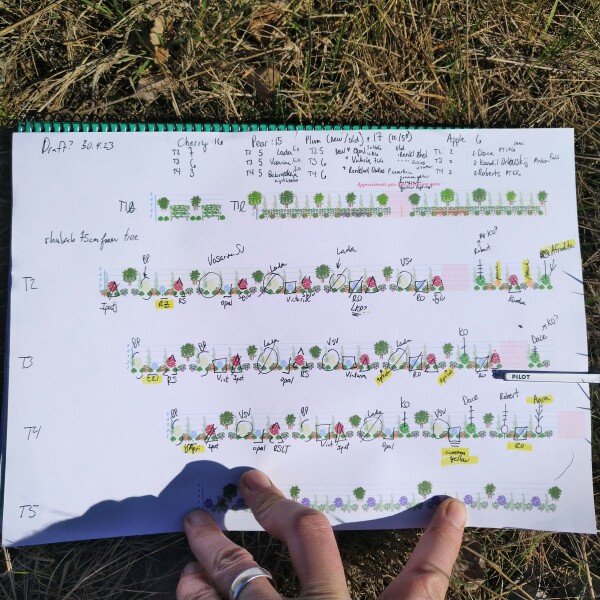 |
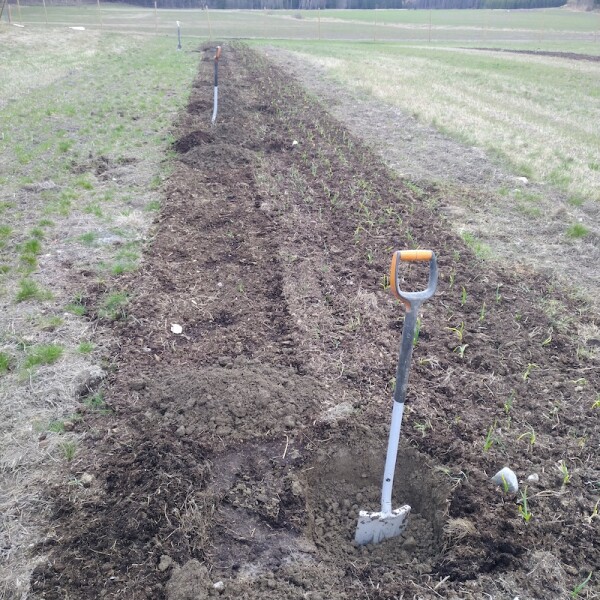 |
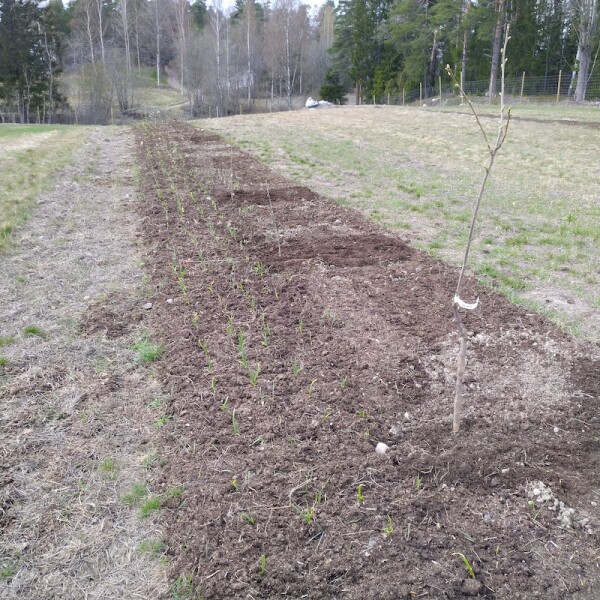 |
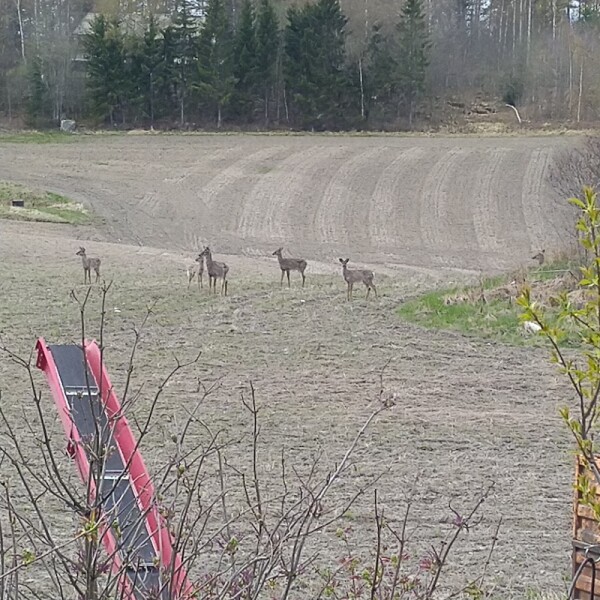 |
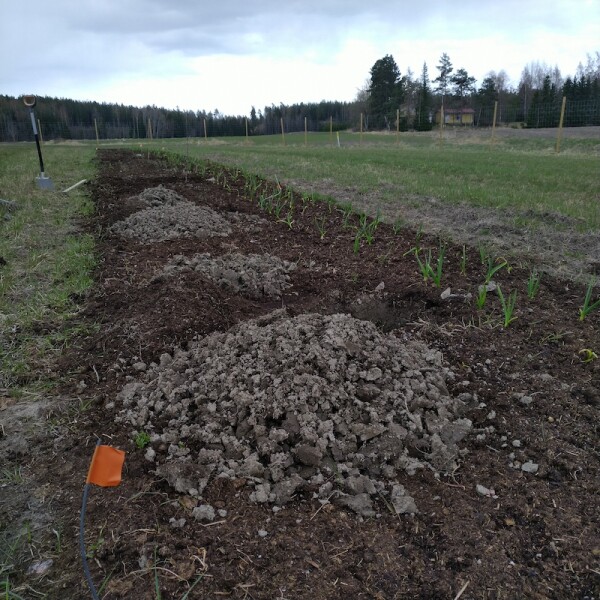 |
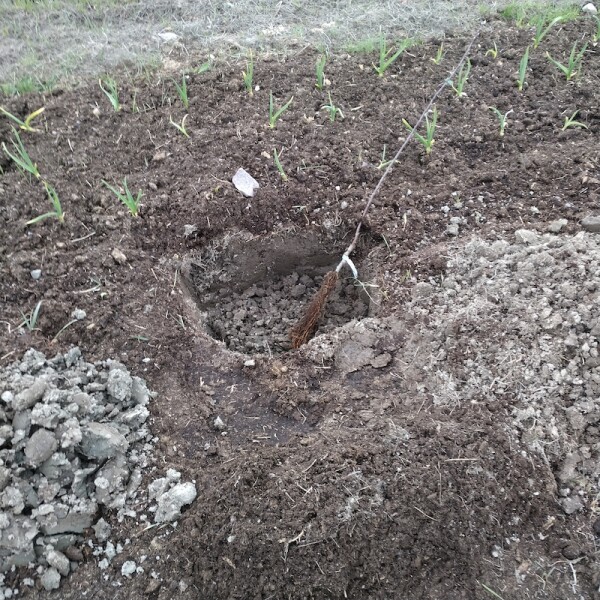 |
Location: #TreeLines
Theme: #Planting, #CashCrop, #BedPreparation
12.05.2023 Garlic Sap Analysis & Gas Line Confirmation
Part of the plan for managing the garlic this year was to conduct sap analysis. Sap analysis is a method of extracting the sap from plant leaves and measuring a number of parameters such as pH, sugar content, and nutrient levels. We received funding to conduct sap analysis on three distinct areas and a fourth undetermined set. The reason we have included sap analysis in our project, to keep it short in this Timeline entry, is to follow what the plants are actually mobilizing into their leaves during the growing season, primarily from the soil. We want to see if we can find indications of important differences between what our regular soil sampling tells us about our soil and what the plants are doing in the field.
By taking a set of older leaves and a set of younger leaves from the desired plant and sending them in together for sap analysis, the laboratory can help you understand what the plants are doing in close to real time. If there are differences in key elements between the young and old leaves, this can tell you something about the availability of those elements in the soil. Then you can decide what you would like to do about it. Part of our plan is to avoid, whenever possible*, adding nutrients directly to the soil. So we will use the information from the sap analysis reports to help formulate foliar sprays.
NovaCropControl in the Netherlands provides over 20 measurements for each set of leaves you send in. For some crops, like garlic, they can provide target values to let you know how your plants stack up to the optimum.
The most revealing thing from this particular analysis was that both nitrogen and phosphorus- two elements that conventional and near infrared soil testing said our soil should struggle to provide- were in great excess. On the other hand, nutrients like potassium and magnesium which were excessive on the soil reports, were deficient in the sap. This hints at, but does not prove, that we have a lot to learn about how plants mobilize nutrients from the soil over their life cycle and indicates the importance of beginning to gather holistic information about soil and plant nutrition.
Further information can be found on our website [here link when available] explaining what we found. Our project assistant, Florentine Che Ngong, wrote a blog post (to which I contributed), about plant sap analysis at Lill-Nägels, which can be found here on Novia's Novialia Blog.
In addition that day we finally had someone identify exactly where the gas pipeline is buried and how large the exclusion zone would be.
(*with the exception of the one time application of horse manure compost, described elsewhere, including on this Timeline, entry 12.08.2022)
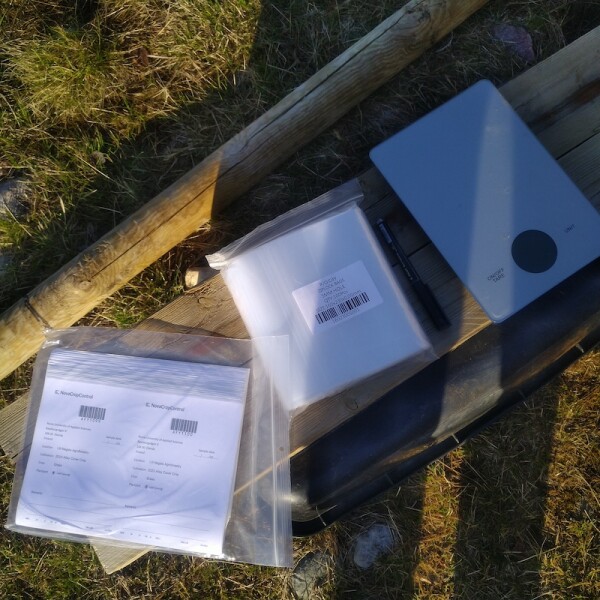 |
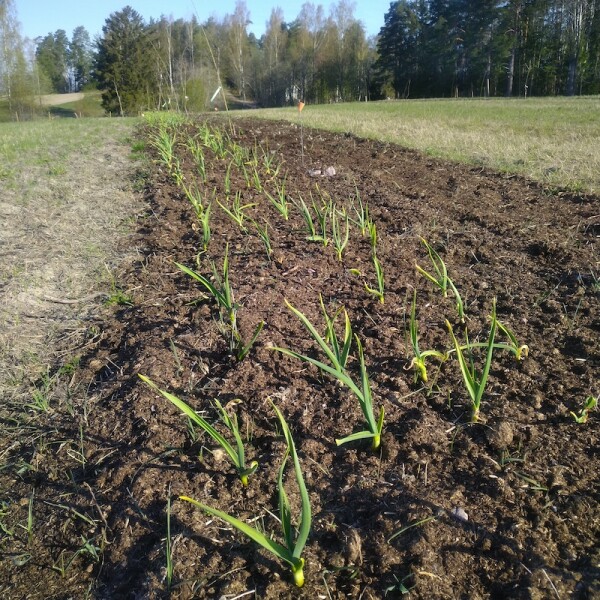 |
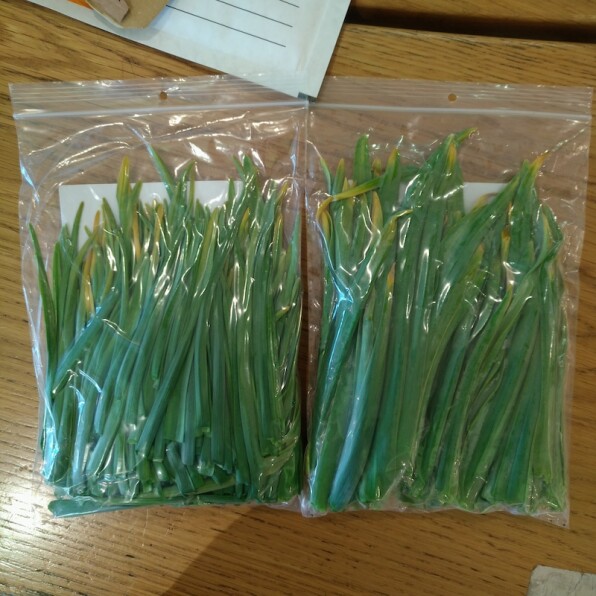 |
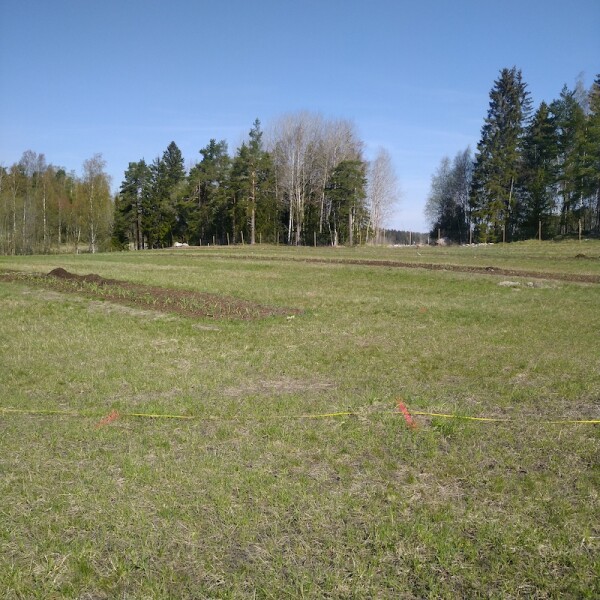 |
Location: #TreeLines, #WholeField
Theme: #Analysis, #CashCrop, #Observation
18.05.2023 First Tillage Event
With the main rush of planting the rest of the farm over, we were able to bring the tractor out with the Vibroflex tillage tool. This time we ran the tool over the entirety of the alley and margin areas. It took Risto, a professional farmer who works closely with Rikard, about one hour to drive to the site, complete the tillage work, and return to the farm.
In the alleys, we wish to "revert" to annual and biennial based production systems, while in the margins we are diversifying the existing, low-grade grass with more biodiversity. You can find more information about the plans for the site under Field Information -> Site Design.
This first tillage pass needs to break and expose the rhizomes of the couch grass (Elymus repens), which dominates the site, to the sun and reduces its vigor. Our plan was to follow up with harrowing- breaking the large clods- a week later.
Alternative choices for killing the grass are in the Alternative Choices section of the website.
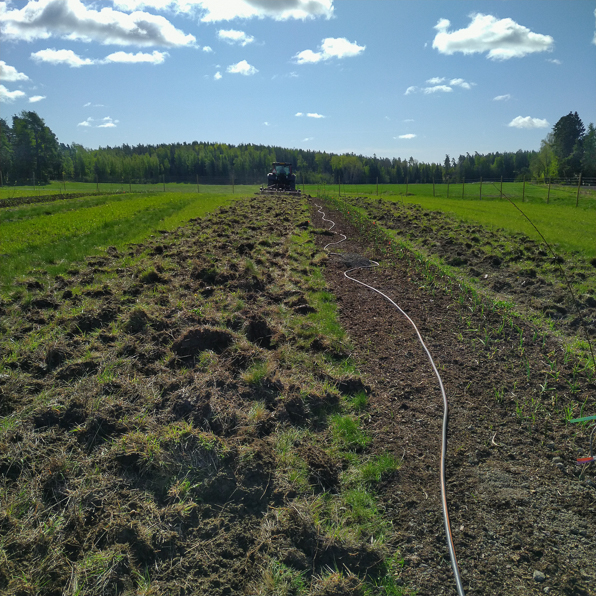 |
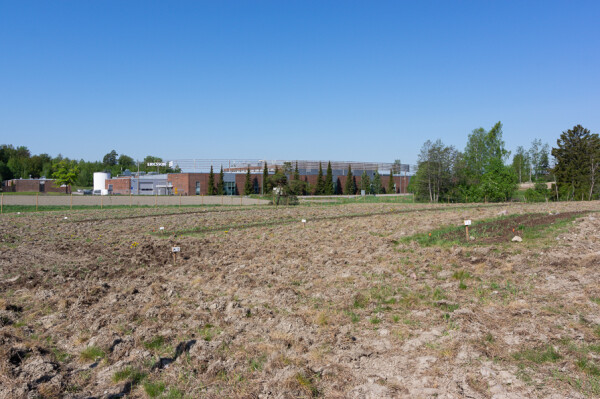 |
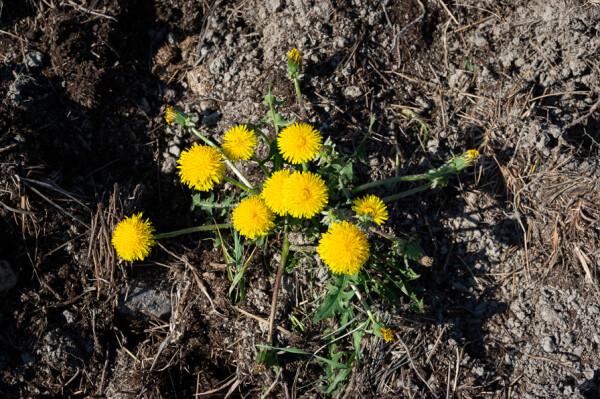 |
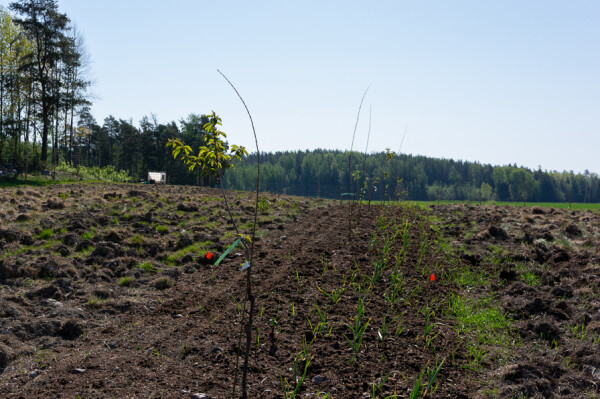 |
Location: #Margins, #Alleys
Theme: #BedPreparation, #CoverCrop, #Observation
20 - 22.05.2023 Agroforestry Open Weekend, Tree Line Cover Crop Planting
We opened the site up to the public for the first time at the end of May to coincide with the international "Agroforestry Open Weekend" event. We had a nice turnout, but as usual, I didn't take any photographs that day! When there are people around I typically try to not use my phone and I find it awkward to snap photographs of visitors.
I also sampled the soil for the first time that spring and prepared those to send to the laboratory. Samples were collected from M1 for clay loam under perennial herbaceous species transition, T4 for clay loam under the polyculture tree system, A3 for clay loam under annual/biennial "regenerative agriculture" transition, and T2's shallow soil section for comparing the "same" polyculture as T4 but with sand loam soil. Enough soil is collected to be analyzed using conventional and near infrared soil testing. Information on those soil samples will be available under the soil testing section.
A couple of days later, the east sides of the tree lines were ready for planting. A biodiverse mix of 12 species from 8 plant families was inoculated with compost and seaweed extracts (the former made on the farm from the project manager's stock) as well as endomycorrhizal fungi spores. The species planted were: Sunflower, Dill, Hairy Vetch, Millet, Annual Blue Lupin, Honeyflower, Buckwheat, Flax, Fenugreek, Persian Clover, Cumin, and Tillage Radish. A diverse cover crop like this has multiple layers of sunlight capture, different root architectures, different growth parameters for weather conditions, and a range of different kinds of blooms for attracting and feeding insects of different kinds. In addition, some of these species like buckwheat and the nitrogen fixing vetch, lupin, and clover are capable of increasing available soil phosphorus and nitrogen respectively.
The inoculation with biostimulants and mycorrhizal spores is a direct attempt to colonize these diverse root systems with beneficial biology that is deficient in our degraded condition, provide that biology with a food source (the plant root exudates), and then continue to foster conditions for the biology to thrive into the future. These are early-stage interventions that will be adapted to meet actual changes on the ground.
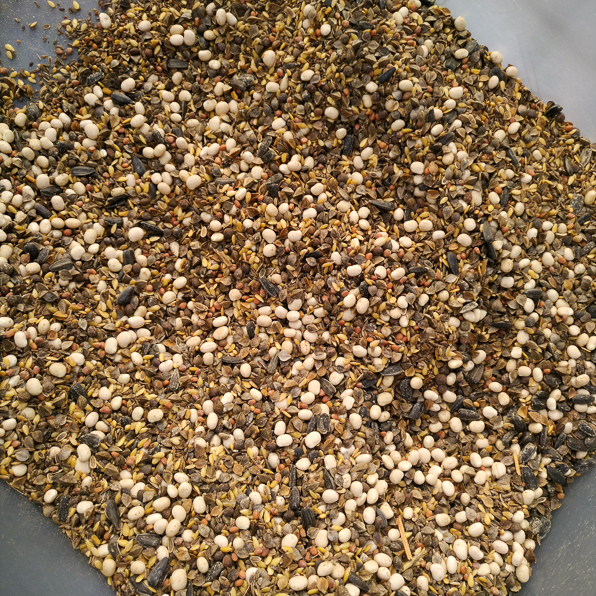 |
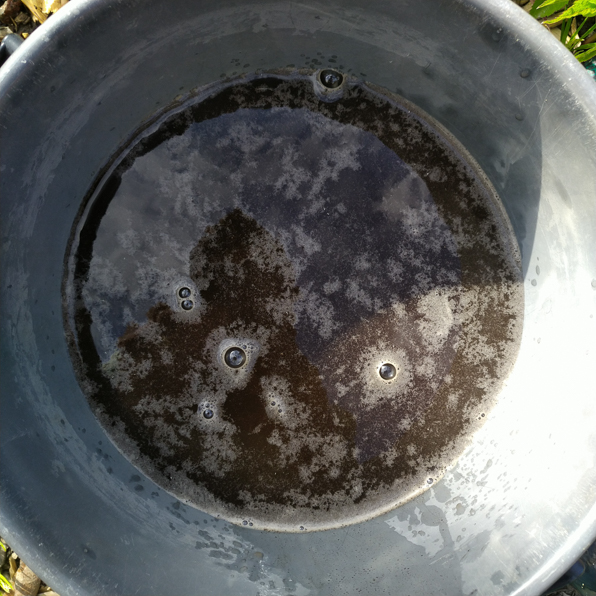 |
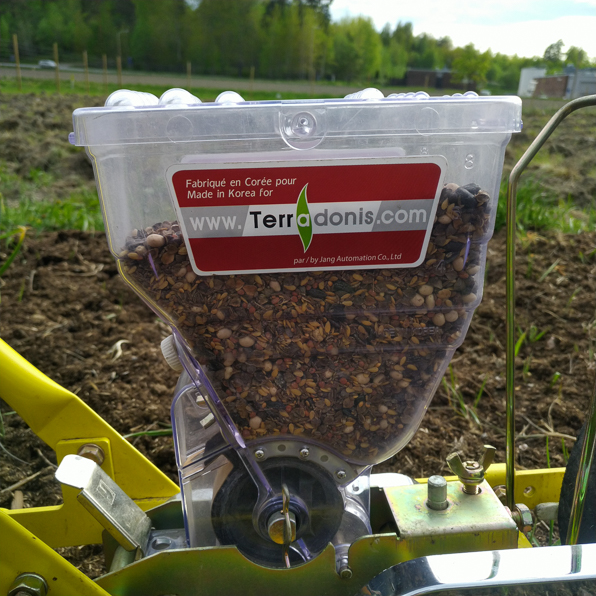 |
Location: #WholeSite, #TreeLines, #OneSiteEvents
Theme: #FieldDay, #Analysis, #Planting, #CoverCrop, #Biostimulant
24 - 25.05.2023 Late Spring Drought, Grape Planting, Support Species Planting, & Harrowing
Spring is always very busy and with a new project, even more so! There was a lot still to do and the need for quick implementation was increased by the lengthening drought.
By this time in May, we had "enjoyed" a few weeks of sunshine- even if it was cold- which is appreciated except for when you do not have irrigation. We arranged for an old IBC (1000 liters) tank to be filled with well water and transported to the site with the tractor. I purchased a hose adapter and was able to use the IBC's position at the top of the hill to trickle gravity feed water to the trees and rhubarb that I had worked so hard to transplant earlier in the year. There wasn't enough water, nor enough pressure, to share any water to the garlic. Even with only giving the trees ±10 seconds of water each, the thousand liters disappeared by the end of the final tree line. Over the next few weeks, I would gravity drip water to the transplants a few more times before the irrigation system was operational month later.
As you might imagine, the garlic was starting to run out of groundwater at this point. Clay-loam soil may hold more water than sand, but with a low organic matter content and poor structure, the total amount it could provide to the plants- let alone the ability of healthy soil organisms to aide plants during drought- was minimal. The early strong growth, despite strong setbacks by the very late and hard frosts, would taper off and the plants would be severely stunted going into June. Essentially that meant that nothing could "save" them from an economic point of view. We'll return to garlic later.
We needed to keep working and get the remaining grapes and willow cuttings into the soil. Most of the grapes have been planted in T1l with just four in T1s. We will build a trellis for the grapes in T1l and, later that autumn, we put in currants as well in the deeper section of soil in the middle of the tree line. In T1s we will join the grapes to living trellises to see how that ancient method looks. Given that it is only about 13 meters long, we figure we have a "spare" part of the system just to have some first hand experience with the method.
There were some encouraging signs though: while many of the early emerging maples from our seed bank deposit last autumn died off due to full exposure to the late frosts and the dry weather, the oaks began to sprout much later and put on their first leaves.
Lastly, the old tractor was hooked up to a pulled harrow- a very old and trusted tool- and brought to the field. I was allowed to break the clods up as much as I wanted for a few hours- it took a while, but eventually the alleys and margins were ready for planting. At least from the perspective of the soil being turned into a seed bed. The lack of moisture was very worrying by this point and even though we had some days of potential rain, no effective rainfall was received until late June.
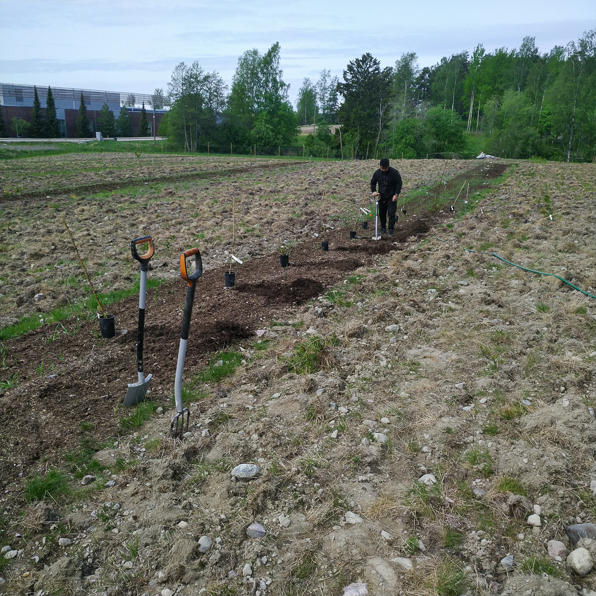 |
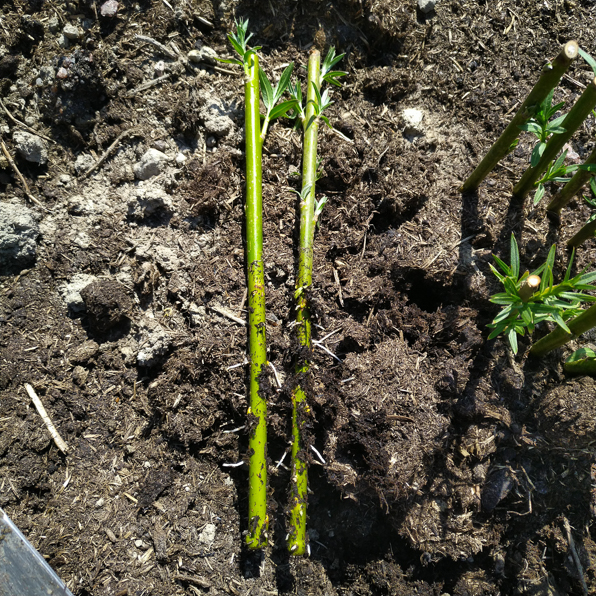 |
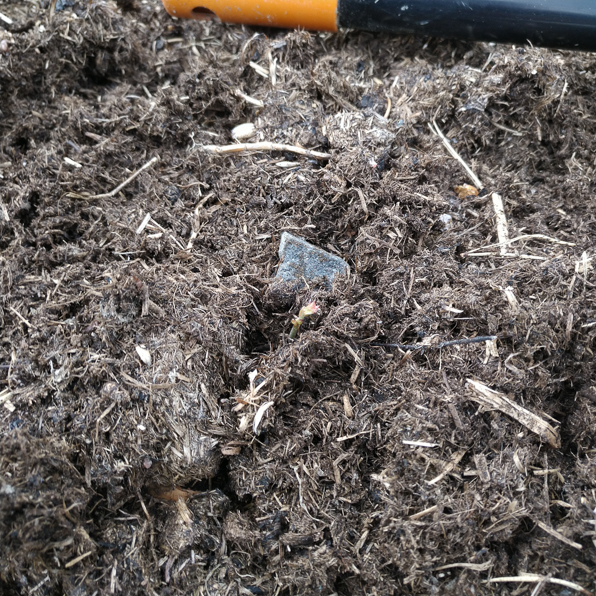 |
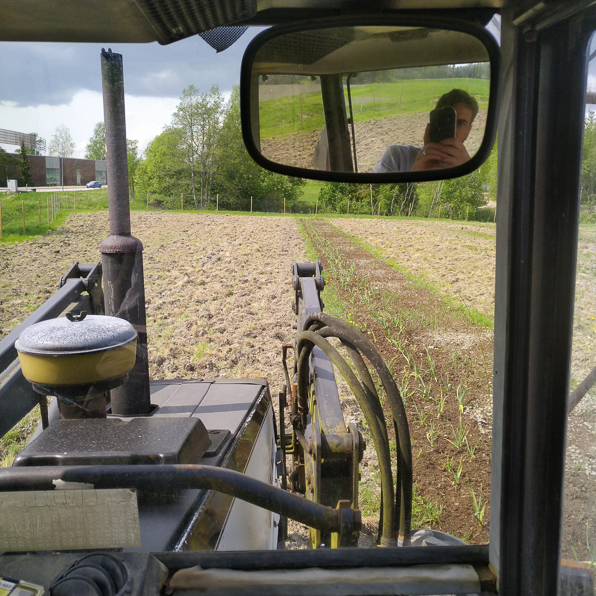 |
Location: #WholeSite, #TreeLines, #Alleys, #Margins
Theme: #Irrigation, #Observation, #CashCrop, #Planting
30.05.2023 Alleys and Margins Planted
A few days later, we brought in Mats Wikner of Wikner Hay Oy to plant our alleys and margins with the cover crop mixes. Mats is familiar with the farm and our site: he helped us in the initiation of the tree lines with his GPS equipped tractor by precisely tilling the sections of the field for T1-T4.
I had prepared two batches of seed for him to plant. This makes things a little tricky, not because the seeds pose any challenge themselves, but because the amount of seed when divided like this can be difficult to meter just-so with his 4 meter wide planter. Typically larger planters like this are filled with enough seed to cover a few hectares at a time, not < 0,5 ha batches. If you have read the other parts of the website, you will know that we have 12 meter wide alleys. The planning there was to use base 3 meter wide pieces of equipment. So the 4-meter planter that we decided to use this spring was a bit oversized, as you can see in the image below! However, 4 meters still fits perfectly into the 12-meter alleys and gets us where we want to be. Especially with a professional behind the wheel.
In the alleys, the plan was to put in this first batch of seeds as a biological primer. Use fast growing, cool-weather tolerant species in May, then terminate them in July (probably by mowing) and plant a summer mix with C4 grasses and sunflowers. Using a succession of cover crops in the alleys like this would allow us to cover the soil with some on-site produced mulch material and then capitalize on the soil cover with taller growing, more productive summer species sown in the warm window of late summer. That second crop would be killed by frost, trap snow over the winter, and eventually be pushed to the ground by 2024's spring time. This is more expensive than a "fire and forget" full-season mix planted in spring and essentially left alone. However, in our situation, we want to get as much biology going in the soil as possible. If we were to plant sunflowers in the spring with everything else, we would lose the ability to mow and set back the annual cover crops- which would force them to produce more root exudates- because mown sunflowers equals dead sunflowers. By separating them we could, with more effort, make more change. At least that was the plan.
But by the end of May, with the drought and the cold weather, things weren't looking so good for this idea. So I replanned the spring mix for the alleys to add a little more diversity and choose to respond later in the summer if conditions warranted. We wound up planting: honey flower, vetch, lupin, buckwheat, Persian clover, calendula, tillage radish, flax, triticale, and cumin. Together this is a ten-species mix from 9 plant families. The seeds were sprayed with compost extracts, seaweed extract, and had endomycorrhizal fungal spores added to them the day before planting. In an attempt to stretch our inoculant, I did not include the tillage radish or buckwheat in the seed mix until after I had coated the endomycorrhizal hosts with spores. In total we used just over 13 kilograms of seed for the ±4000 square meters of alleys we had at the start of 2023.
The mix for the margins was left unchanged. Here, we had much more diversity: between 5-6 grasses (e.g. Italian rye grass), sunflowers, vetch, cumin, honey flower, buckwheat, flax, calendula, tillage radish, lupin, millet, triticale, Persian clover, chicory*, crimson clover, alfalfa*, red clover*, alsike clover*, sainfoin*, white clover*, sweet clover*, caraway*, salad burnet*, fenugreek, plantain*, ribwort plantain*, dill, fennel, coriander, sheep's parsley*, bird's foot trefoil*, and eastern parsnip.
This amounts to 36 different species from 11 plant families. Those marked with an asterisk (*) are biennial or perennial species that we wish to survive and grow into the future, diversifying the perennial margins. Some of these were added in small quantities from older cover crop mixes. We believe it is important when establishing perennial mixes to include annuals as a nurse crop for the slower growing perennial and even some biennial species. This type of nurse cropping uses the concept of succession- matching species to time and place. Annuals can help compete with any unwanted species and will exit the system over winter. If some establish themselves as self-seeded individuals it is ok. Likely we will add more diversity at a future date once we see how the meadow is establishing. In total, we planted 10,5 kilograms of seed. These were also inoculated in the same manner as the alley seed.
The soil was very dry by now, having been tilled then harrowed quite thoroughly and no effective rainfall occurring in the meantime. The photograph below shows quite well just how bad the wind erosion is on our site when soil is exposed. Our hope is that our management will eventually make pictures like this a thing of the past. It was also on this day that we decided to pause our future plan to add the Perimeter tree lines that would run perpendicular to the existing tree lines. Mats' handling of his tractor is superb so he was able to navigate the site with such a large kit, but we now will bring the new combine to the field in spring to test-run the system with its current (late 2023) configuration with 16 meter wide headlands.
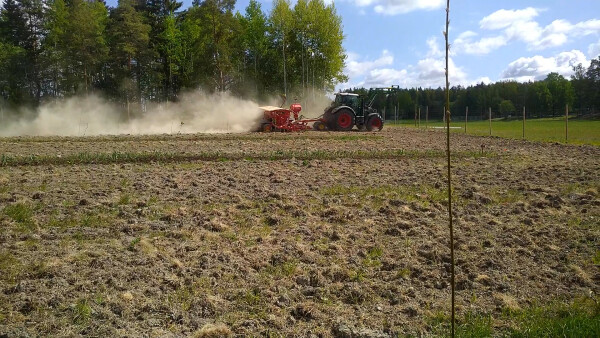
Location: #Alleys, #Margins
Theme: #Planting, #CoverCrop, #Biostimulant
06.06.2023 Weed Pressure Mounts: Occultation
One thing that a drought cannot hold back are hardy pioneer perennials like couch grass. Despite the efforts to control them through 2022's drought, the rhizomes which were underneath and immediately adjacent to the tree lines benefited from the soil cover provided by the composted horse manure. The moisture retention and mineral soil temperature mediation were beneficial to the grass roots which were below the management zone of a colinear hoe. These roots could send up new shoots and, as the compost dried out due to a lack of rain and no irrigation system, the management of those new growth became difficult. This is because dry compost does not hold the blades of the grass as firmly as wet or moist compost does: it is not sticky and becomes loose and fluffy. So when a blade is passed through the compost later, it may be easy to pull, but the hoe usually just pushes the grass down. This is a sad state of affairs and requires a back and forth motion, doubling or tripling the amount of labor needed to a) push the grass over and b) come back the opposite direction with the hoe's blade and try to get the bent point cut.
Eventually I "gave up" and switched to a hand-held electric grass trimmer, which dropped the time to manage the grass down considerably despite not being ergonomic. This would not be feasible for the entirety of the tree system, so we invested in silage tarps to perform occultation with.
Stones were pulled from around the site and used as anchors for the plastic. Usually people would use sand bags or even large metal staples, but removing the surface stones from around the field and using them to hold the plastic was another idea to help with the planting and eventual management of the alleys and margins of our project. So once the plastic had done its job, we could take the stones and use them elsewhere- likely building some raised beds and one-rock dams in the no-go zones around bedrock outcrops.
We turned the silage tarps to the white side up in order to reflect as much sunlight as possible given the heat and drought we were in. They were added to the east side of the tree lines and would be moved to the west side after the garlic harvest. Without any water and the head-start the grass had, the cover crop planted there would simply not compete.
Another benefit of the silage tarps is that they can be moved. We have tarps in both 1 and 2 meter wide sections which will allow us to position them as needed around the site. In addition, once we decide which of the P-lines to install in late 2024, we can use the silage tarps over the course of the whole 2024 growing season to eliminate the perennial weeds both where the tree lines are meant to be planted as well as 0,5-1 meters around the entire edge of their location. Using the silage tarps as edge management is going to be crucial in our site given the ability of couch grass to proliferate from the smallest area. Until the system is more mature, handling the grass is going to be an ongoing bit of labor.
If the system had been established in a degraded field still devoid of most perennials almost all of our weeding would have been unnecessary.
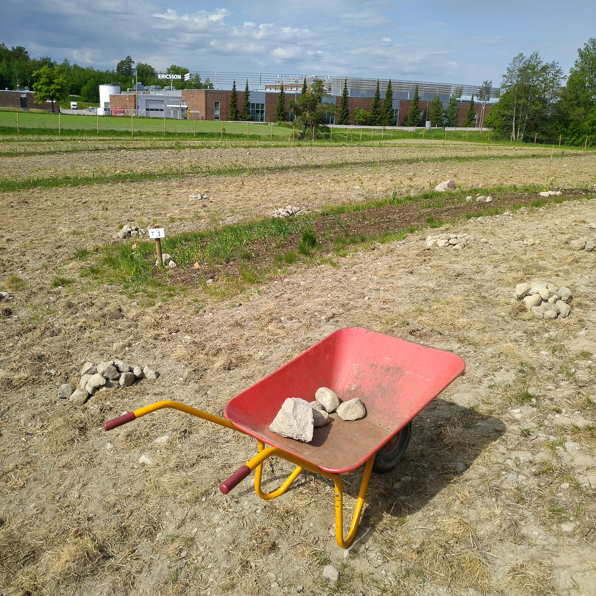 |
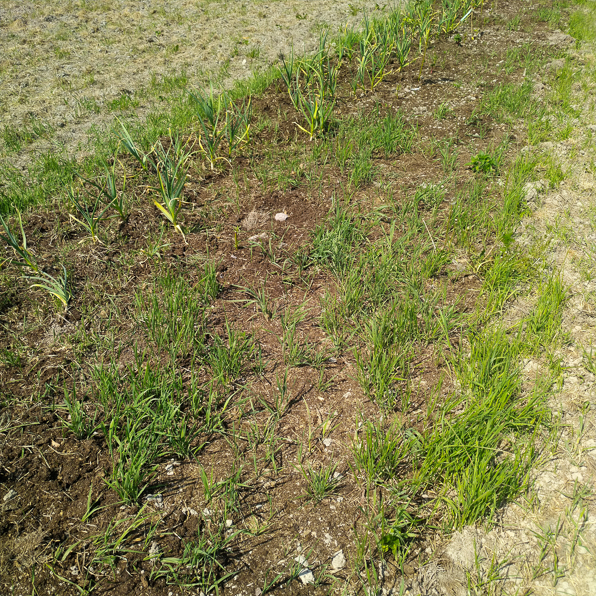 |
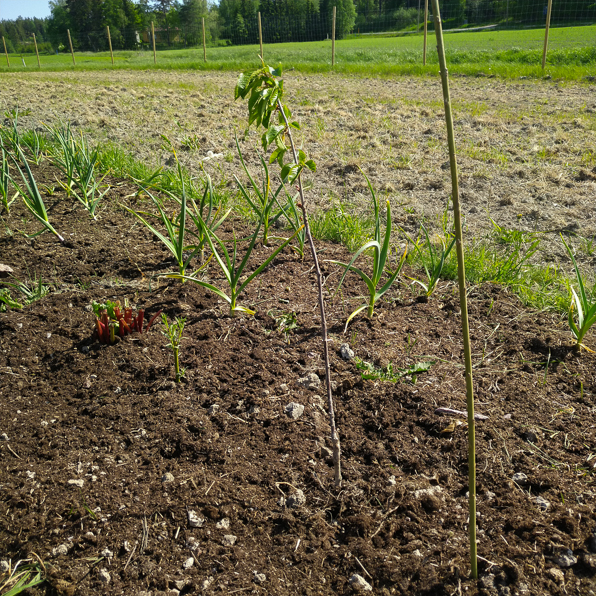 |
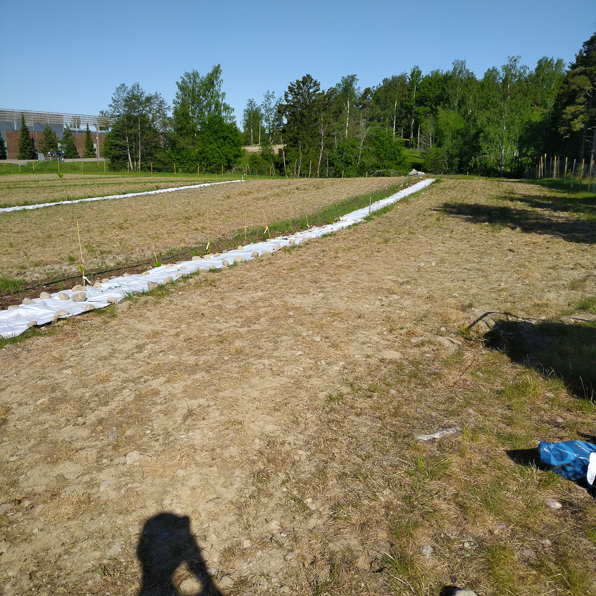 |
Location: #TreeLines
Theme: #Weeding, #CoverCrop, #Occultation
13.06.2023 Agroforestry Business Model Innovation Network (AF4EU) Workshop on Site
Together with Tanja Kähkönen and Michael den Herder who are working with the Agroforestry Business Model Innovation Network (AF4EU) project, we were able to host a gathering of farmers, advisors, and officials at the Lill-Nägels site in mid-June. The AF4EU project is a Horizon Europe project with partners across the continent, so to be able to host one of their Finnish workshops was a real honor. It was also a pleasure to get to meet so many new people and show them our site, such as it was in the drought. There were a lot of great questions and conversations about agroforestry. One thing we needed to make clear was that our site is piloting next generation systems and we do not know how it will turn out. We've pulled together indications from various research publications and farmer experiences to design something unique to our part of the world. So it was important for us to ensure everyone knew that agroforestry can be many different things and that our LillNAP project you are reading about is very much a trial.
Despite the drought and poorly looking plants, the amount of effort that has been put into the site and the project overall left a positive impression on many people.
Next year I will be sure to take photographs of events or ask someone else to.
Location: #WholeSite, #OnSiteEvents
Theme: #Workshop, #FieldDay
19 - 29.06.2023 Irrigation System Install & Drought's End
Our irrigation system was delivered by Schetelig Oy in late June, 2023. At this point I had been working alone for some time and the heat and stress was taking its toll. So its arrival and the next ten days of installing the system were a kind of time-outside-of-time for me as the project manager. I had somehow kept the trees alive through a drought with only seconds of water from a gravity fed IBC tank to tide them over and now things were going to change.
The day the system arrived, Risto was with me and he joked: just watch, as soon as this is ready, it is going to rain. We laughed.
The irrigation system is the single most expensive investment we have made, outside of the labor to plan, document, and manage the site of course. We chose Schetelig because they were the most willing to work with us on our novel needs (see Field Information -> Site Design -> Irrigation [bottom of page]). Eventually we decided that a full drip system would be the most appropriate and I set about putting the bobs and ends together while Rikard arranged for an electrician to run the necessary electrical infrastructure from the farm to the farm pond.
The hardest part was not the never ending sun- the site has zero shade- but getting the drip lines run out by oneself. Running drip line is definitely a two person job when they come in rolls measuring hundreds of meters long! Because the IBC was now empty of water, I removed the plastic container and dragged the metal cage out into the field. By putting a few of the spare fence posts through the cage, I was able to hoist the drip roll onto a butt end and pull tape without the whole thing dragging on the ground. Occasionally this worked well, but more often the tape was being unwieldy and it took a lot of back and forth to untangle it. The bottom of the IBC shell offered a little bit of shade which was welcome: I took breaks from the sun crouched next to the drip tape quite often in my solo race to get this ready for the big day. At my old farm we called this kind of jury rig "permaculture engineering."
Sure enough, by the very end of June the first effective rainfall was recorded. Strong thunderstorms came through the area and the entire weather pattern for the remainder of the growing season shifted from dry, dusty, and hot to cooler and more wet. Still, the irrigation system was a must for helping the trees recover from their long period without enough moisture and to get the cover crops established in late July.
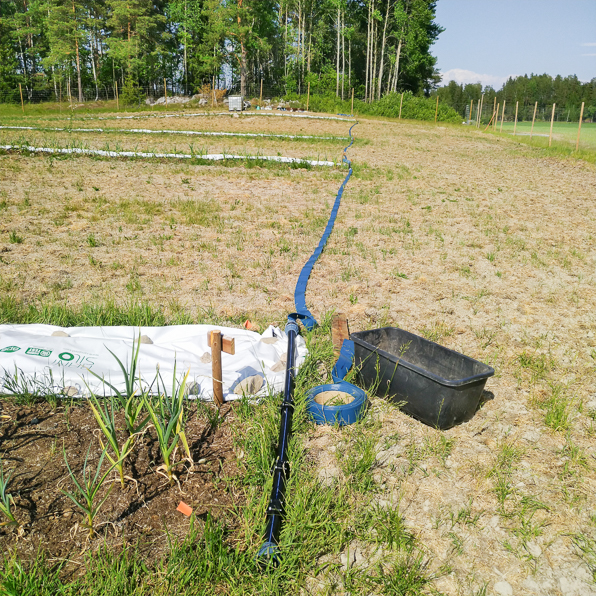 |
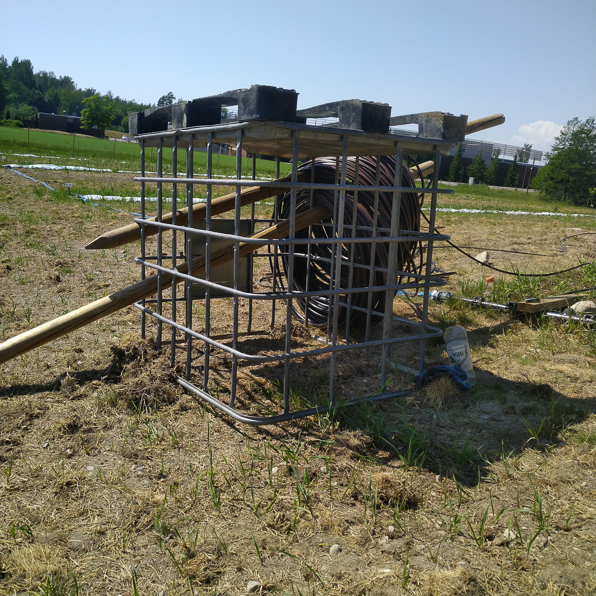 |
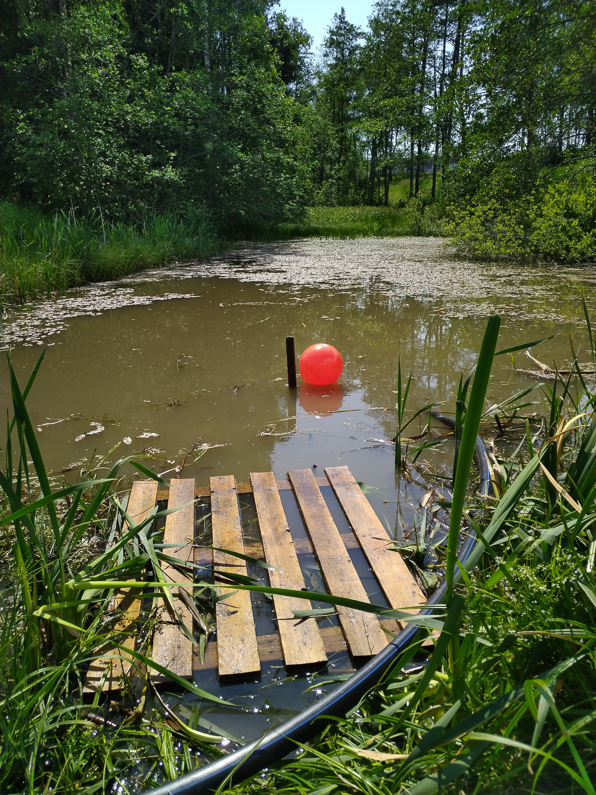 |
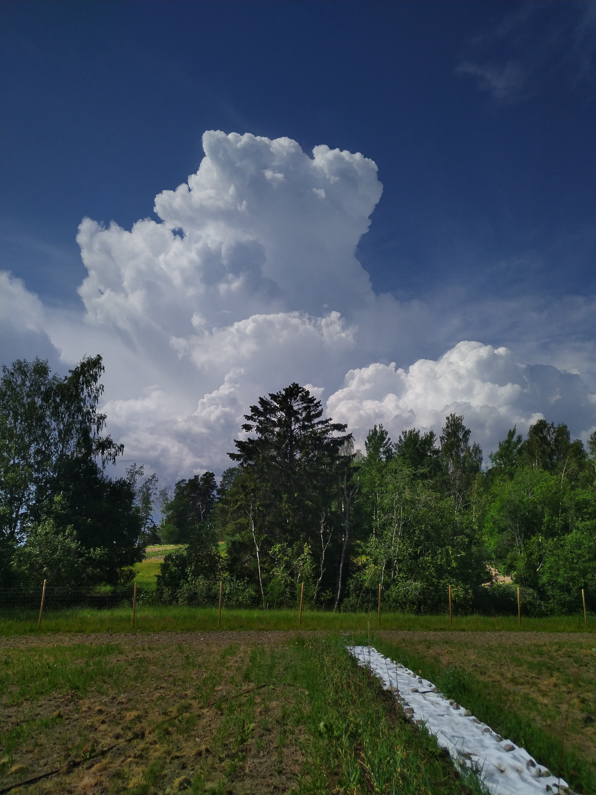 |
Location: #TreeLines, #WholeSite
Theme: #Irrigation, #Infrastructure
30.06.2023 - 05.07.2023 Soil Profiles
I began digging 2023's soil profiles with the sand-loam section of T2, then down into the other sampling areas with clay-loam (A3, T4, M1). Given the back to back droughts I did not have any expectation to unearth anything of significance. Soils develop in conjunction with living roots from healthy plants. Without inputs of either of those, there could be little chance of positive developments yet.
Detail of the soil profiles can be found in the Soil & Plant Analysis Section of this website.
Included here are photographs of the soils under the tree lines, with T2's soil profile being immediately recognizable with the high sand content. The reference images for the general area of alley 3 (A3) and margin 1 (M1)'s profiles show just how much bare soil there was- exactly the opposite of our intention. Very little of the cover crops have begun to germinate yet even with the first rain beginning to fall.
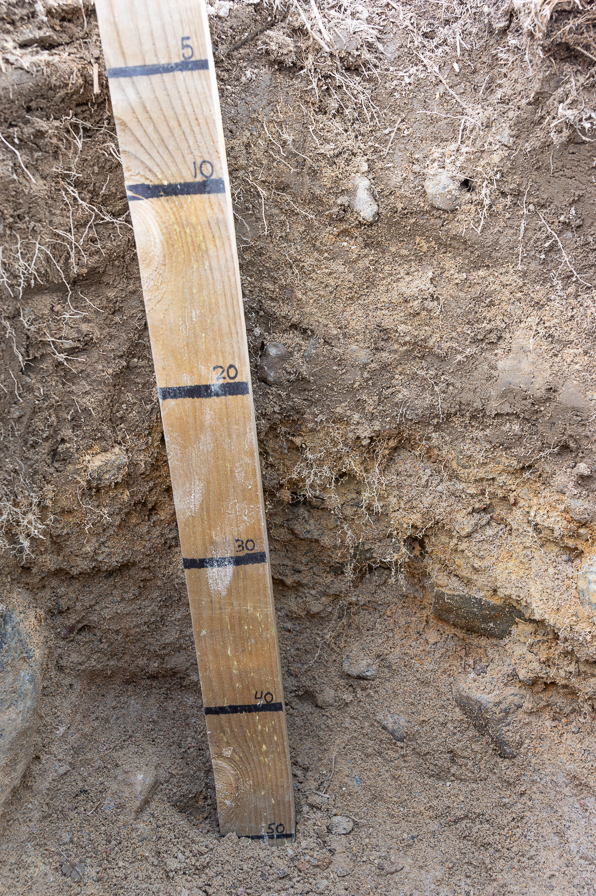 T2 sand loam T2 sand loam |
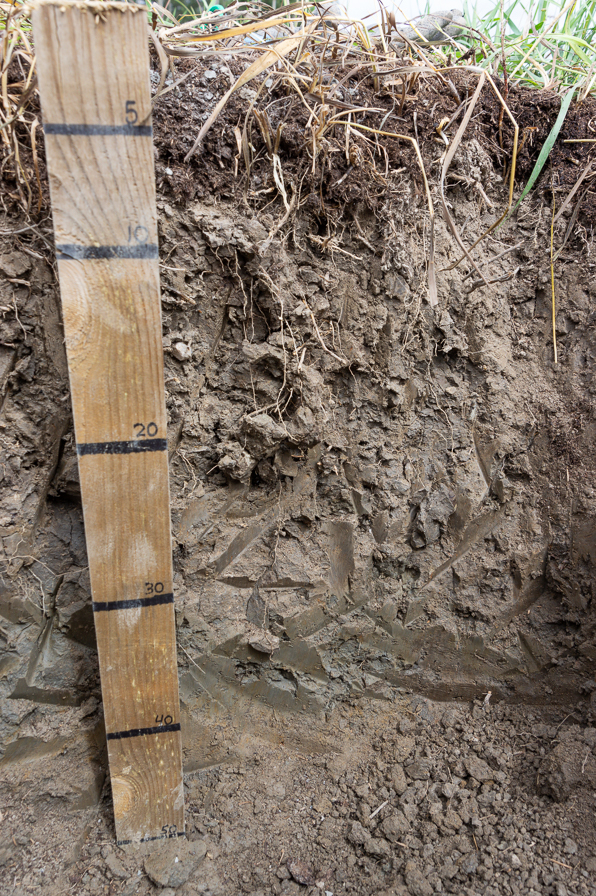 T4 clay loam T4 clay loam |
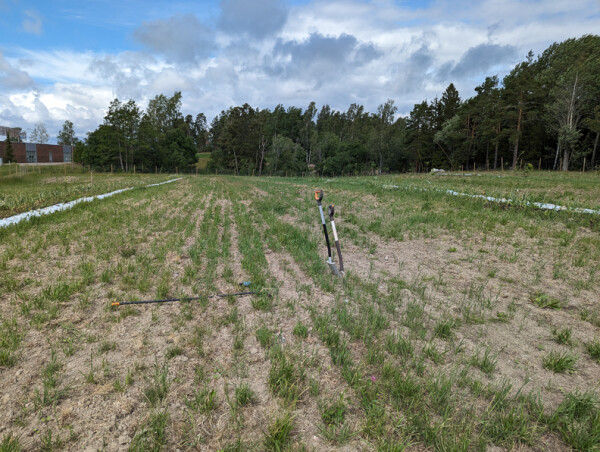 A3 General View A3 General View |
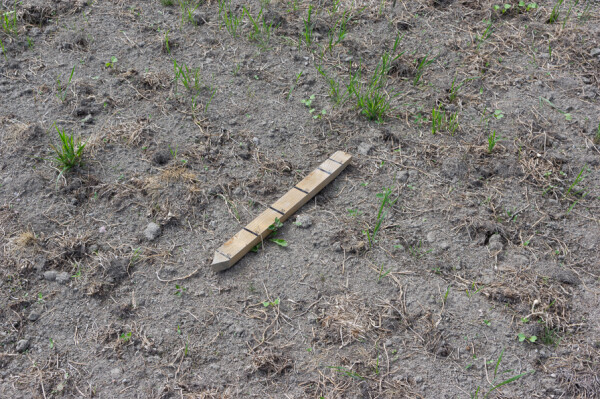 M1 Soil Surface before profile digging M1 Soil Surface before profile digging |
Location: #TreeLines, #WholeSite, #Alleys, #Margins
Theme: #Observation, #Analysis
30.06.2023 - 05.07.2023 Heading into Summer: Growth Images
With the irrigation system up and running, we set the timer to provide water to the central zone of each tree line for twenty days. This amounted to less than 4 liters of water per meter, per day. With emitters spaced every 30 cm, this is about 1,3 liters of water per emitter, per day. That spacing allows an emitter to sit close to the crown of most of the species we had planted. Over time, this added up and allowed us to hydrate the soil under the trees thoroughly for the first time. Irrigation for the trees was not needed again until a month later for just a few days.
Although the garlic was a failed crop by this point, we continued to see it through to the end by harvesting the flower scapes, such as they were. Interestingly, except for T2's worst hit areas, most of the garlic did not actually die from the drought. It survived. But without enough water to grow properly, our harvest later in July would be a failure. It was at this time that I decided to terminate the small garlic in T2 that would not be worth spending the time harvesting by scything it down. I could then begin removing rhizomes of the grass from the west side of the bed in preparation for planting a cover crop. These areas had plenty of weeds still, but the removal was something that needed to happen. If you want to avoid perennial weeds like couch grass (not all perennials are rid of this way), see Step 3 of the Alternative Choices section.
I've also included a general view of the site by the first week of July and some of the cover crop seed beginning to germinate in the alleys.
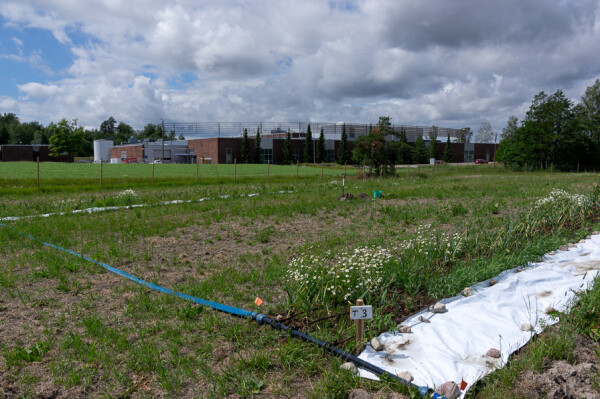 |
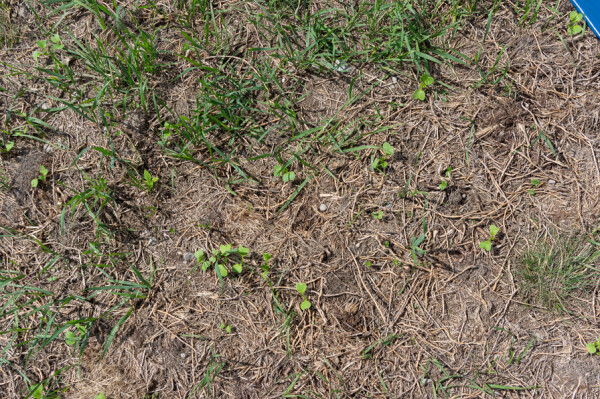 |
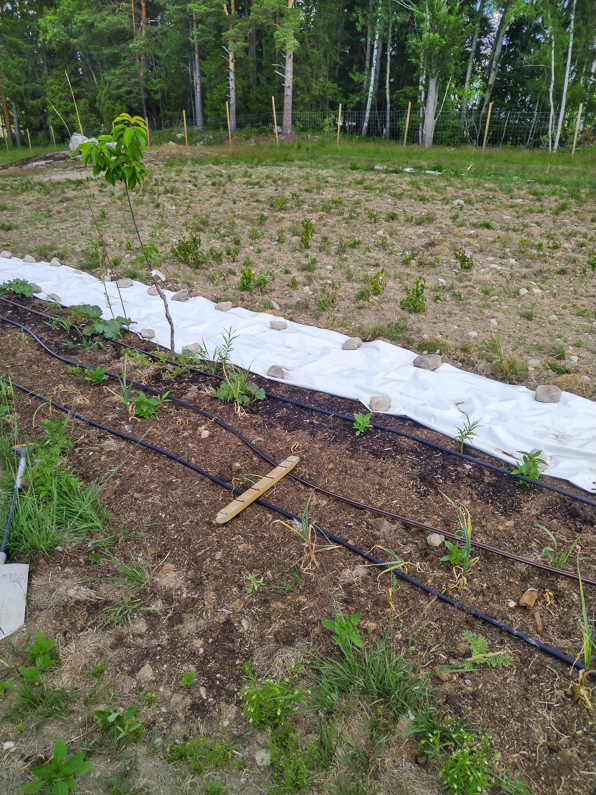 |
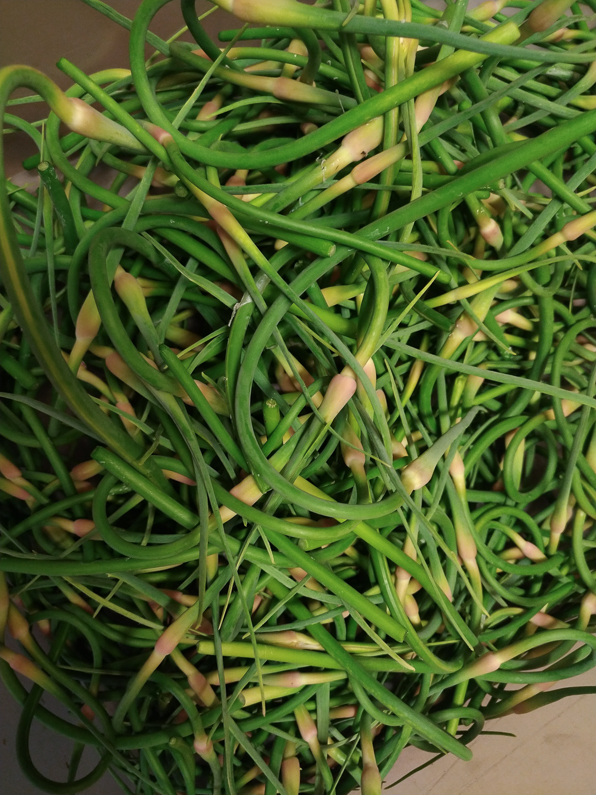 |
Location: #TreeLines, #WholeSite, #Alleys, #Margins
Theme: #Observation, #Irrigation, #CashCrop, #CoverCrop, #Harvest
18.07.2023 Post Vacation: New Assistant and Recovery
I took my vacation in early July, between the installation of the irrigation system and the harvest time for garlic. We had also hired a project assistant to work for ten weeks starting in late July. Florentine Che Ngong joined the team straight away on that first Monday back and we set to work making observations and plotting out a course for the next few weeks. There was a lot to catch up on if we were going to make an effort to turn things around. It is hard to overstate the importance of having a second opinion and set of hands, especially from a fellow farmer like Florentine.
On that first day we already had come up with a way to differentiate the post-garlic weeding process. Briefly: T1l would see mowing continue, but planned around allowing the grass to grow and using the material as mulch. As this section has our experimental grapes, we feel that it makes sense to go all the way with the successional agroforestry method. Eventually, the addition of mulch should suppress the grass to a large degree. In T1s, T2, and T4, we would remove the grass after harvesting garlic. Once this was complete, we would sow a diverse cover crop according to the original plan. In T3, we would place a plastic silage tarp immediately after harvesting the garlic and allow occultation to take place, delaying the rhizome removal for spring 2024 when a cover crop needs to be planted.
We set about completing the work in T1s and T2 that I had started just before my vacation and were able to plant the cover crop as well as seeds of elm (Ulmus glabra), which ripen in the summer, into T1s' center line.
While checking the effectiveness of the occultation process, we noticed that where the central drip had irrigated the compost enough, decomposition was beginning to take place and the first mushrooms appeared. This was quite the moment for us as it shows how, given the right circumstances, nature begins to fill the niches. We'd notice later in the summer that even leaving a few rhubarb leaves on the soil surface as mulch in random piles would attract earthworms to the most unlikely locations.
The situation by the end of even our first week together was on a very different trajectory. From beginning to fall behind with the effects of working alone and drought in the spring, to a holding pattern around the arrival of the irrigation, and relief after the vacation the project's potential was starting to be realized.
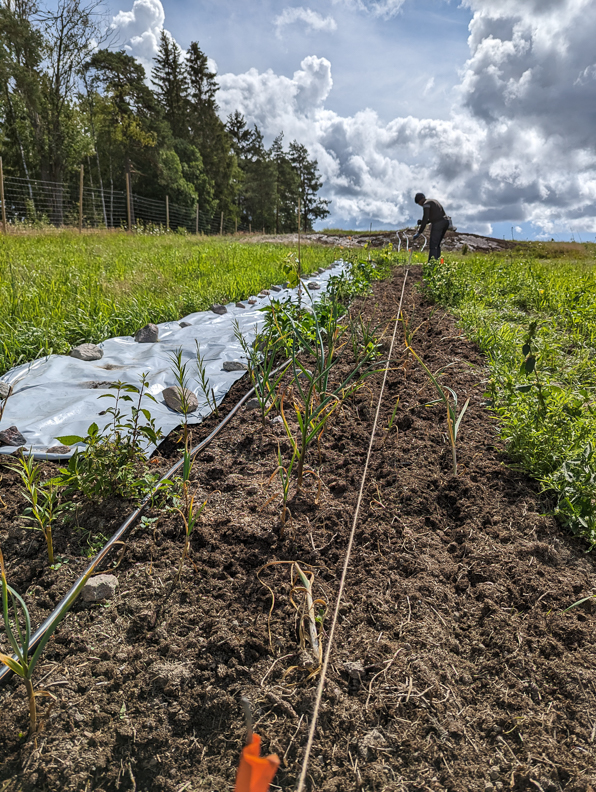 |
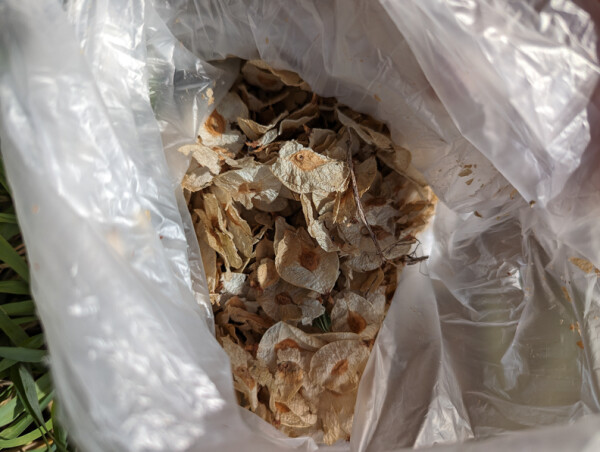 |
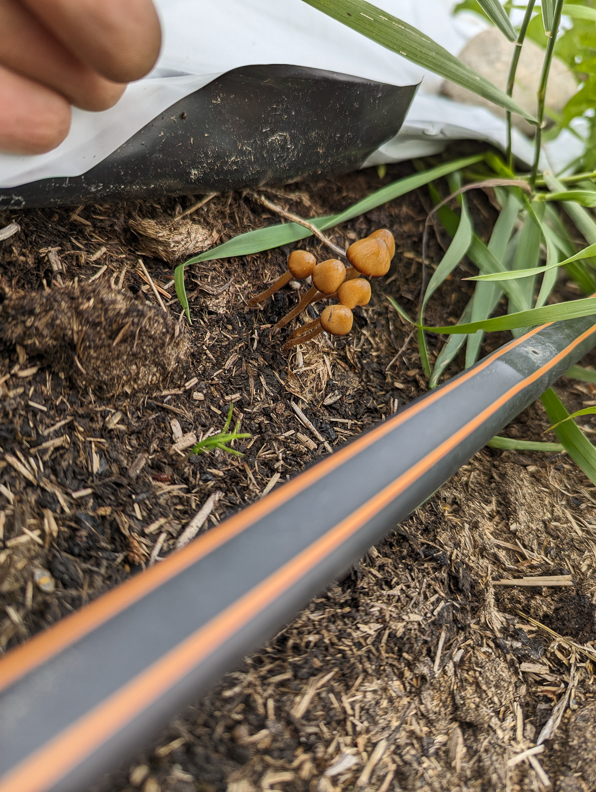 |
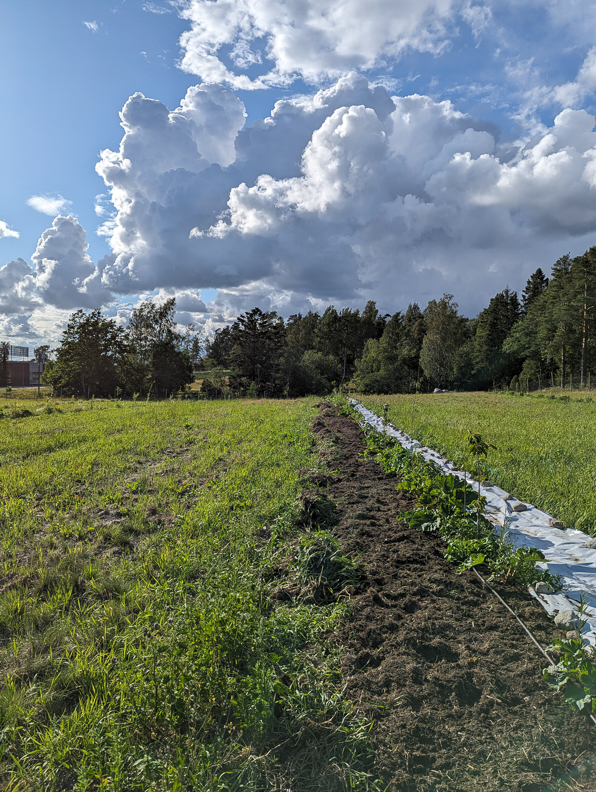 |
Location: #TreeLines, #WholeSite, #Alleys, #Margins
Theme: #Observation, #Irrigation, #CoverCrop, #Weeding, #Planting
21 - 24.07.2023 Garlic Harvest
For this entry, I will copy some passages from reports sent to the project's steering committee about the garlic.
"The conclusions from this year are:
- The garlic failed primarily due to drought
- The very cold spring also caused problems for the smallest garlic
- The good news is that the larger and medium sized cloves…
- Had very high survival rates
- At times produced even large garlic bulbs, despite no irrigation
- With irrigation and less weed pressure, garlic for 2024 should have many advantages
- Lastly, neither the failed garlic nor the garlic for 2024 will actually have been cultivated according to the plan:
- We have not successfully raised a cover crop in place prior to planting
- The garlic planted in the autumn of next year for harvest in 2025 will be the first to follow the plan (in Tree Lines T1s, T2, and T4 at least- see the final section of this report)
- Overall poor soil health- low soil organic matter, low soil biodiversity, the lack of aggregation, high levels of compaction, imbalanced calcium to magnesium CEC ratios- of course are basal issues we are trying to address through management of biodiverse communities."
As alluded to in earlier timeline posts, yes, the garlic was a failure. We purchased 60 kg of seed garlic, carefully sorted it down to 46,235 kg, planted it with good spacing and inoculation, yet the resulting total harvest was only 43,705 kg. Not only is that less that the weight of the planted seed, that is the fresh weight with tops. That means the marketable amount was about half of this about 24 kg. That marketable weight is a far cry from the 192 - 326 kg of estimated marketable yields based on prior yield data from the same cultivar grown locally. Given that farmers are price setters for this level of garlic production, that means we went from projecting a profitable crop to a loss:
- "Estimated Economic loss at 1 500 € expenses: - 1086,90 €
- Difference between lowest estimated profit and loss: 1 873,74 €"
- (The low estimated revenue was just shy of 2 400 €, with a projected profit of just shy of 900 € including the 1 500 € expenses)
It cannot be emphasized enough that, taking the fact that most of the medium and large garlic plants survived but didn't grow to a marketable weight, the lack of moisture was the issue. The site is not only full sun with no shade, it also is very exposed to wind and has a southwest facing aspect. These existing site conditions have been analyzed in the Field Information -> Site Analysis section of this website, hence the decision to have irrigation.
The irrigation system arrived just too late to help. The system would have needed to be operational already by the end of May to be useful given how dry the site is. In another entry we will document what the situation looks like for 2024's garlic.
Although not exactly a silver lining, we did manage another yield from this garlic failure: we collected 13 sap samples at the time of harvest, which help give a bigger picture of the nutrient situation in the garlic prior to harvest. Potassium, iron, zinc, and copper were deficient and this information is incorporated into the nutrient management plan for 2024 by ensuring we have those inputs on hand should 2024's sap analysis show we have an issue.
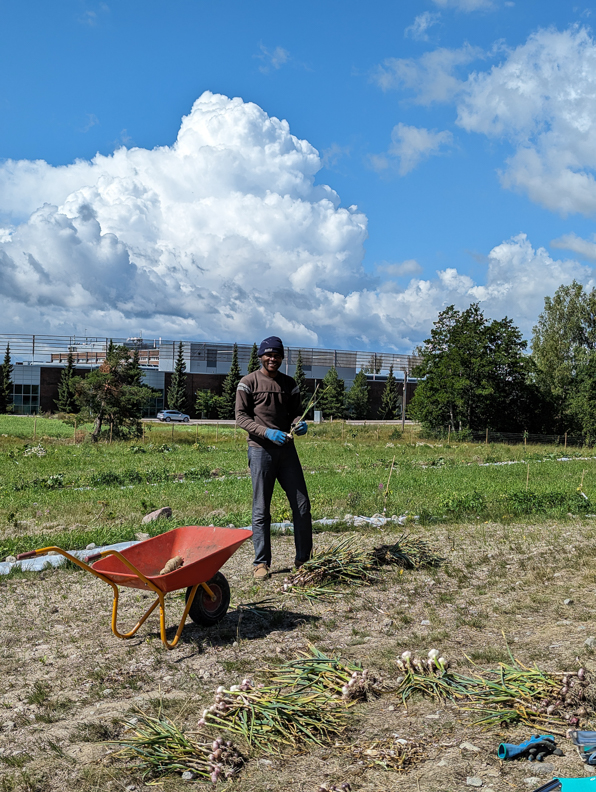 |
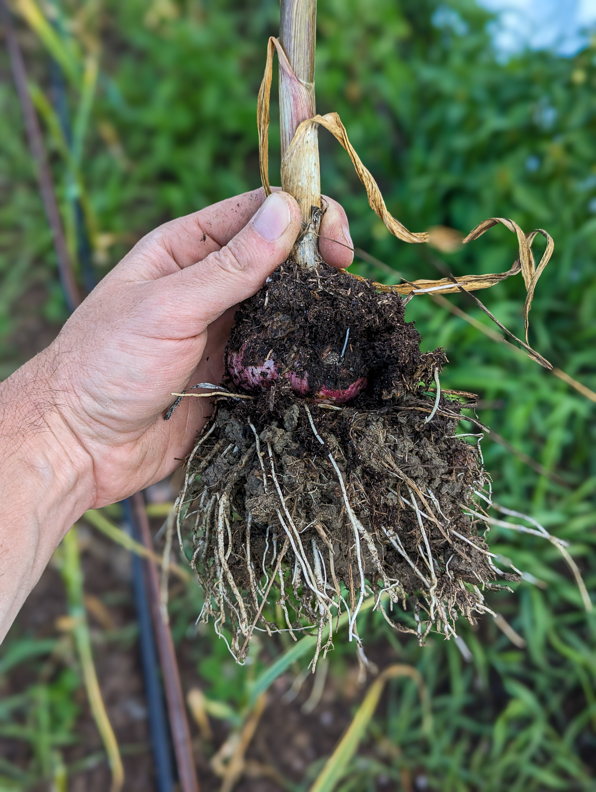 |
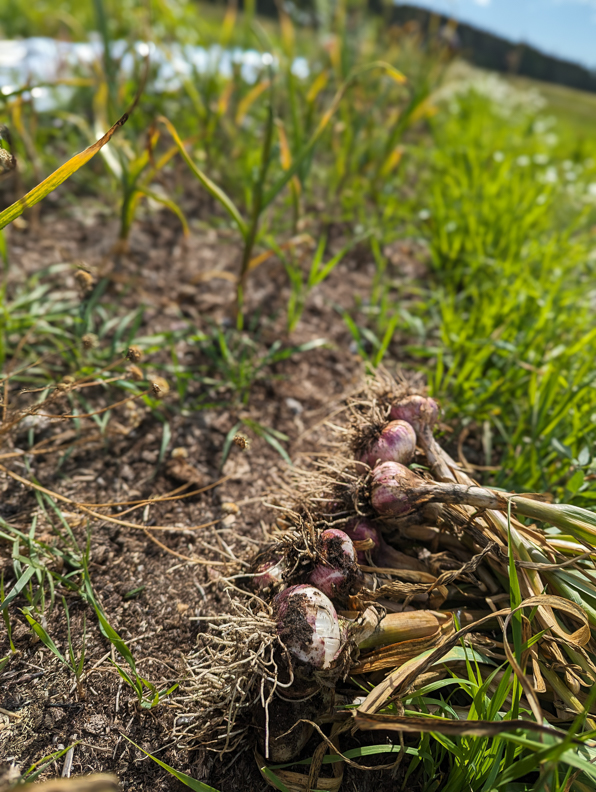 |
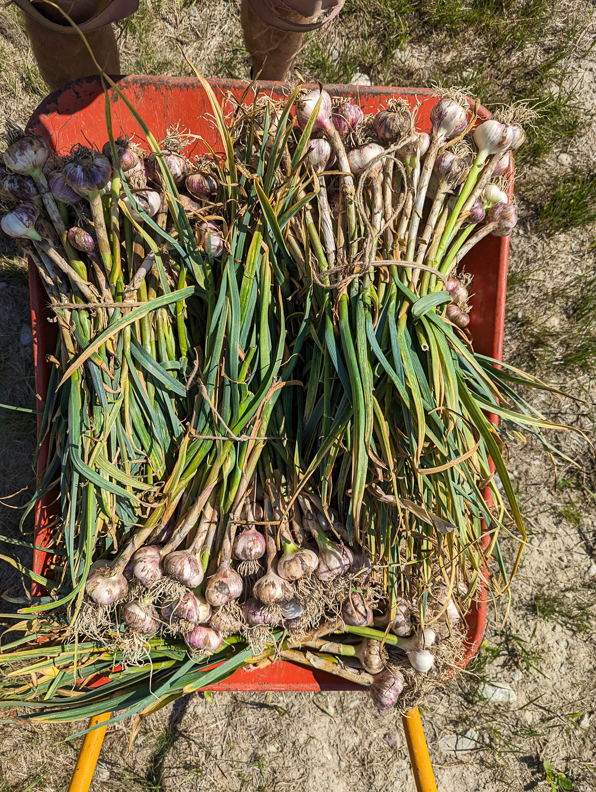 |
Location: #TreeLines
Theme: #Observation, #CashCrop, #Harvest
24.07.2023 Foliar Applications and Sap Analysis
At the end of July, the effects of the back-to-back droughts were beginning to wear off. Plants were recovering and entering the final 6-8 weeks of good growing conditions in southern Finland. It was high time to support the recovery of the alleys and margins by using the boom sprayer on a tractor. The tree lines are managed- at our scale- with a 12 liter backpack sprayer and had received foliar treatments three times thus far.
Our goal for this season was to use sap analysis to guide the formulation of foliar applications of nutrients and biostimulants to support known deficiencies in the species present. However, one effect of the drought that did not wear off was the fact that we had very little plant material to actually send to the laboratory until very late in the season. Prior to the 24th, we had only enough material to test garlic a couple of times as well as a couple of anomalous grass samples. There simply wasn't much material to gather, even from the couch grass. In addition, while sampling the grass during a prolonged drought might prove interesting, applying foliar nutrients to grass without access to water wouldn't exactly produce much by the way of change. Also, we want to get rid of the grass in the alleys, so any support given exclusively to couch grass would have to have been relegated to the margins. Not worth a cost benefit analysis of firing up the tractor.
So we had to rely up on a couple of grass samples, the conventional and near infrared (NIR) soil analyses, and our own observations to determine what to add. From those, it appeared that we were having some issues with nitrogen- which hadn't been added to the soil since, most likely, 2017. We eventually settled on a mix of compost extracts (4,6% of total), seaweed extract (2%), and fish hydrolysate (1%) to be added to 150 liters of well water. Both the fish and the compost extracts were made with local materials. The compost and seaweed extracts have high carbon contents, which can help buffer the nitrogen coming from the fish hydrolysate. As fish hydrolysate was made from nearly whole fish, it had a range of nutrients which bacteria had converted into a liquid.
With the tips of a 15 meter sprayer folded in, Risto was able to spray the concoction in less than 45 minutes time. In order to track changes- correlation, not causation- we took extensive grass sap analysis (8 samples) the very morning before spraying and one week later. Of the nutrients N-P-K evaluated, all three rose in the grass samples between the 24th and 31st of July. Another six vital nutrients also rose during this time period. Exactly how much of the changes to those nutrients and the others samples was directly attributable to our intervention we cannot specify. However, going into 2024, we have some indication of what that combination of ingredients appears to have caused and we can then modify our formulations based on this.
We were also able to see whether or not the sprayer confined its effects to the alleys and margins by testing some rhubarb- albeit not as many plants as we would have liked- which show very little change in comparison to the changes seen in the grasses.
Our Soil and Plant Analysis pages deal with these issues in more detail. [Not ready as of time of publishing, lots to catch up on!]
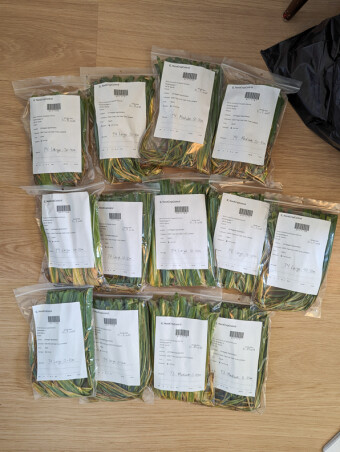 |
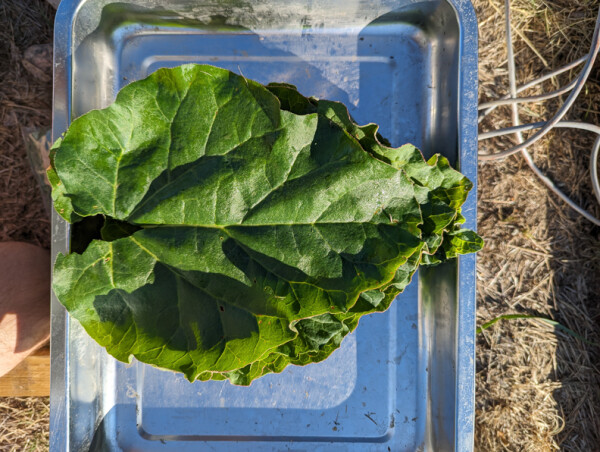 |
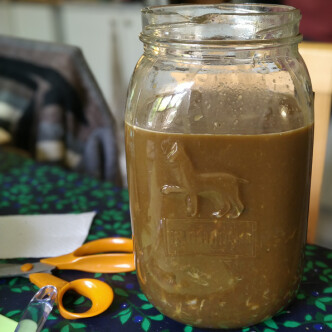 |
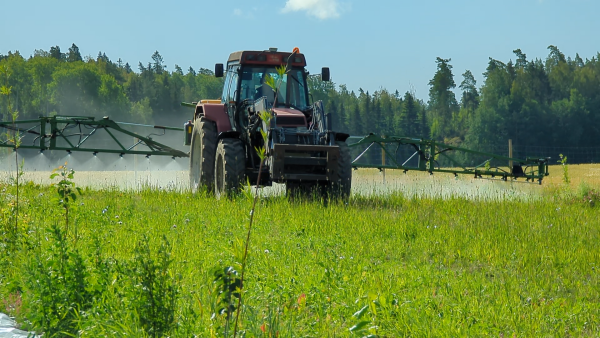 |
Location: #TreeLines, #Alleys, #Margins, #WholeField
Theme: #Observation, #Analysis, #SapAnalysis, #FoliarFeeding, #Foliar, #Biostimulant
25.07.2024 Some General Views
I can say that with the garlic out of the ground, sorted, and drying- even though it was a poor harvest- the feeling was that the site had turned a corner. We were now doing more of what we had set out to do and could look forward rather than behind.
Here, I'm including a few photographs from the 25th. In one we can see the effect of occultation after close to two months where we had just shortened the tree lines to potentially create room for the perimeter tree lines. Although the decision to make them shorter had been made months earlier, the garlic from 2022 had been planted along the whole length of the tree line so we had been using the entirety of the 2022 design until late in July.
In another, we can see the recovery of the trees in one of the tree lines. Apple, peach, cherry, peach, and apple march down T2 with the beginning of a more regular plant formation after the gas line break to the left. The effect of removing rhizomes can clearly be seen on the west side of those beds, now that the garlic was no longer in play.
Moving to the opposite corner of the site, we have a view looking northeast from the northwest corner of the site, showing M3 and the north ends of the tree lines. The soil here is really poor and even the couch grass is having trouble growing.
Lastly, we have another view from M3 but looking south along A2. The point where the alley vegetation begins to recover is a very clear line. The third margin is quite wet, which has meant that this section's soil is more compact and anaerobic than many other parts as evidenced by direct observation as well as satellite imagery.
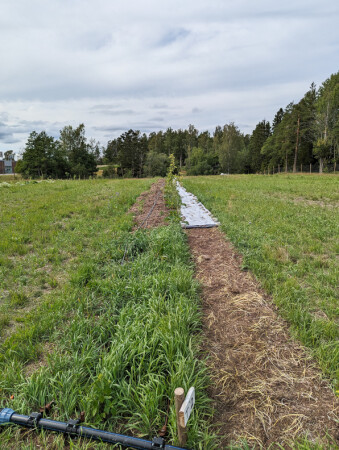 |
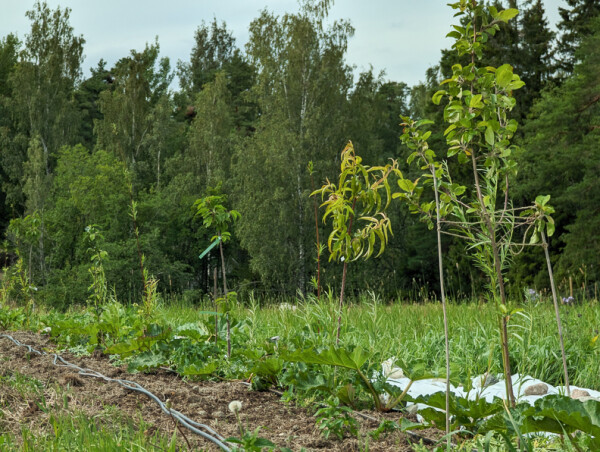 |
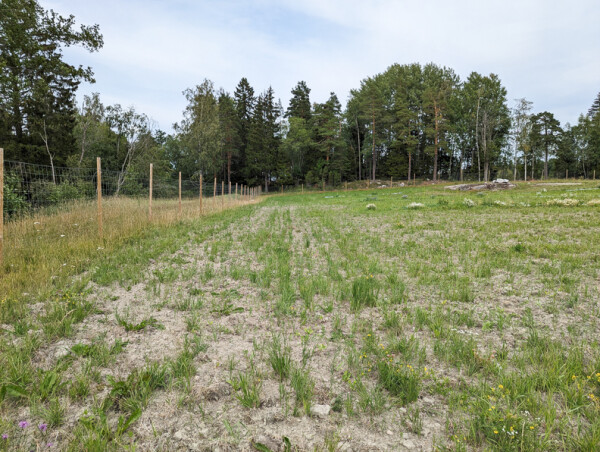 |
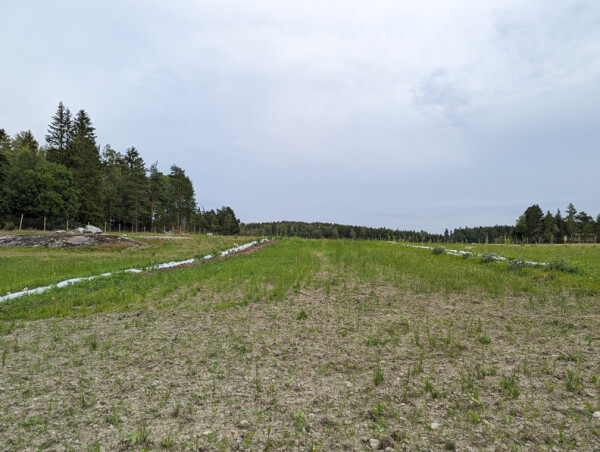 |
Location: #TreeLines, #Alleys, #Margins, #WholeField
Theme: #Observation
07 - 11.08.2023 Other Observations
If it seems like there are so many updates all of a sudden, it is because once plants begin to grow and express themselves there is a lot more to pay attention to and document than during a drought.
When we pulled back the occultation silage tarps from the bed ends, the cover crops that were sown in late May began to germinate exactly where they were meant to be. This shows the ability of seeds to wait for optimal conditions. The compost they had been sown into was so dry that it wasn't until rain could moisten the surface that there was enough moisture to germinate.
Other cover crops were not so well fated. In the center of another photograph we have a buckwheat plant that "bolted" after making perhaps one true leaf after over 60 days of summer. I have heard many stories of the first years farmers with degraded land begin to transition into a regenerative model and I think this buckwheat shows it all. Not only is its growth stunted, but the coloration of the leaves also indicate how unwell it is. The second full season, 2024, will need to have some better weather conditions to get our soils going so that we can transition back into production agriculture.
If you compare the growth of that buckwheat plant to another field owned by Rikard, the difference is amazing. Rikard has a small plot near the railway station at Jorvas and has been planting primarily sunflowers there for a couple of years now. Local people can come pick bouquets of flowers and wire him a payment through a mobile app. These flowers grow nearly as tall as an adult and were well in bloom by early August.
Fortunately, where we could spend more time caring for our plants, things were going better than the majority of the site. The final photograph is of a black elderberry cutting from my old farm planted down in T4. Immediately adjacent to it are oak seeedlings, early succession willow trees, and even the corner of a goose berry also from my old farm. Weeds have been carefully arranged around the base of the trees to reduce soil temperatures and begin nutrient cycling. These are baby steps in the right direction!
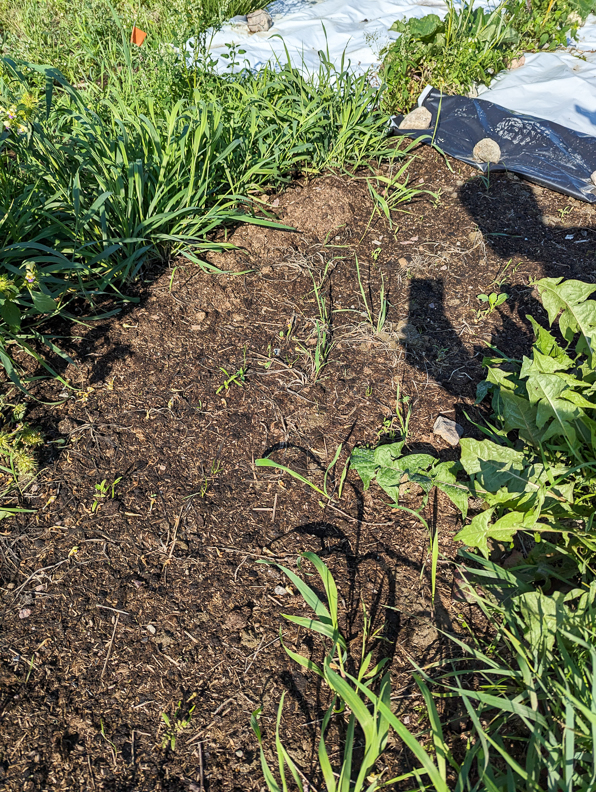 |
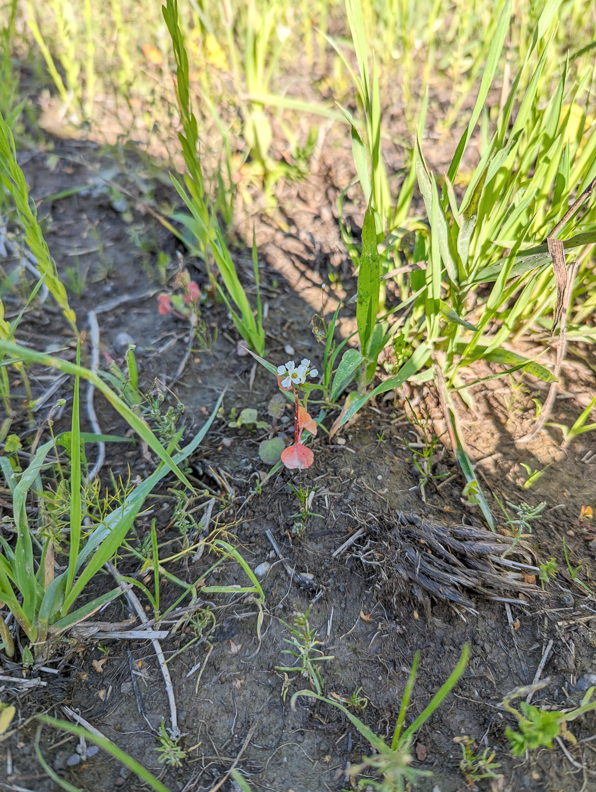 |
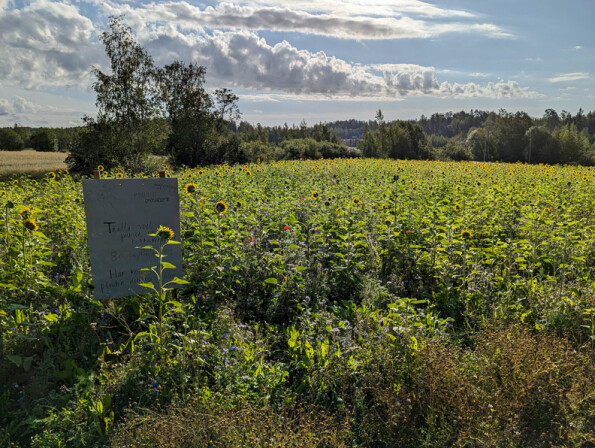 |
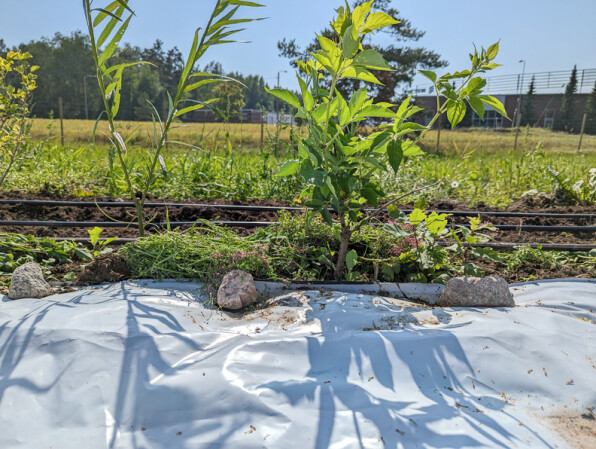 |
Location: #TreeLines, #Alleys, #Margins, #WholeField
Theme: #Observation
14 - 15.08.2023 Cover Cropping in the Tree Lines
At the basis of our project is the idea that biodiverse plant communities are essential for building soil and forming ecosystems. Whether these polycultures are based on annuals, biennials, or perennials, we are always looking to incorporate at least 4 different plant families in each mix to have a broad range of above and below ground architectures, flower types (if they "flower" at all), climatic tolerances, etc.
When the smallest garlic failed completely in the sand-loam patch of T2 west, I planted a mix of cover crops by hand the same day that Mats was planting out the alleys and margins in late May. This is a reflection of paying attention to the fact that, if soil conditions allow for decomposition and there are no plant roots present, the aggregates- that are only built by biology- can no longer expand or be repaired. The carbon that holds them together is set upon by decomposers and the aggregated soil particles (sand, silt, clay) begin to fall apart. Without active plants, soil becomes dirt. Almost 3 months later (10 weeks), this cover crop had finally started to grow with the help of our irrigation system. Many annuals begin to reduce their root expansion and root exudation (feeding of soil organisms) when they switch into their reproductive stage. When some of the species in this cover began to reach this stage, we decided it was time to cut it and replant, using the biomass as mulch. There'd still be time for the new seedlings to establish themselves and begin another cycle of soil building. So we've included a photograph of this just before cutting.
The next photograph shows the state of the cover crops in T2 further down the tree line to the south: first true leaf stage. You can also see the use of the grass from the "tag ends" of the tree lines- those areas we will turn into margins/headlands- being used as mulch around a willow-oak-apple-rhubarb polyculture. The oak is hard to make out in these photographs on this website, but if you look hard you can see it at the base of the willow (left of the soil thermometer).
The third photograph shows T1s, which we had planted one month before the picture was taken. This had been sown by hand rather than the seeder as well since it is so short and shows what one month of cover crops supported with a little bit of irrigation can accomplish. They have almost closed the canopy and will help reduce the growth of weeds.
Lastly, we move to T4 which was planted last with cover crops. Florentine is standing next to a patch where we have rolled up the occultation tarp to check for the reemergence of grass weeds. This is a simple test to see if the plastic has done its job or not. The cover crop in the foreground are those plants which were sown back in May and germinated in the tag end.
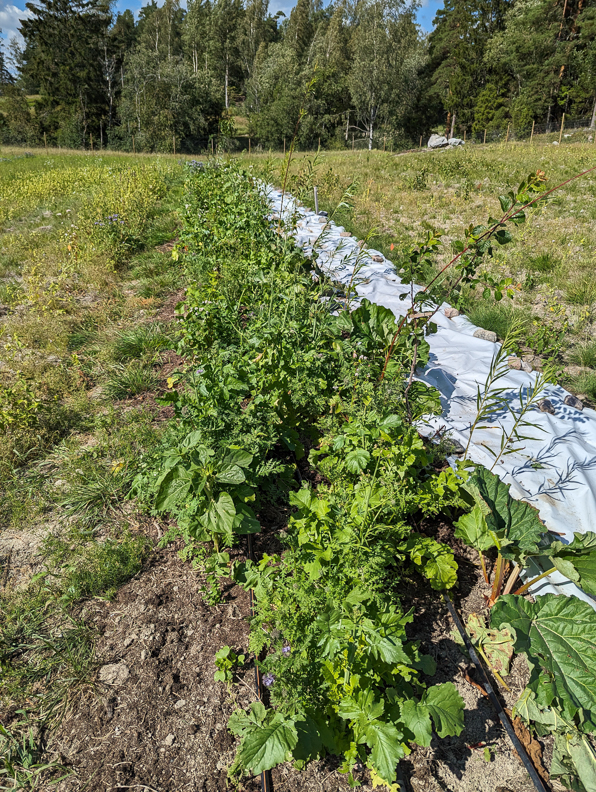 |
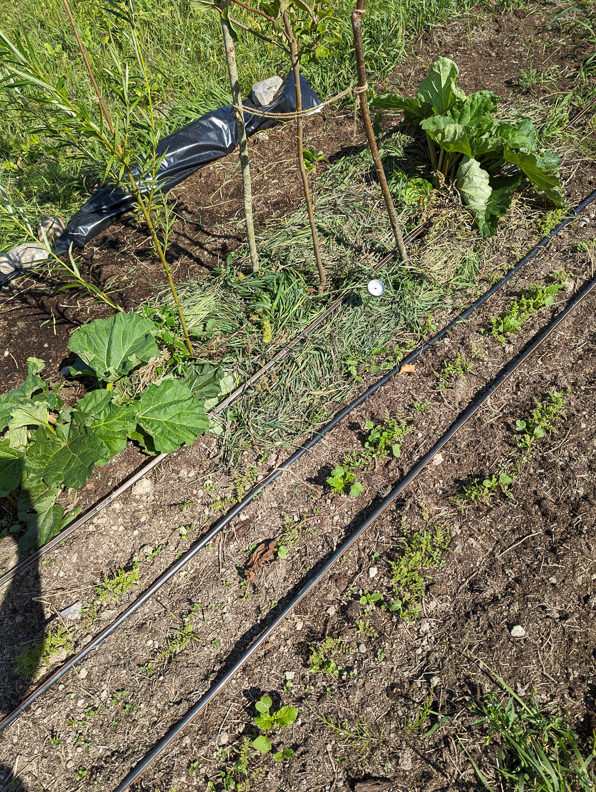 |
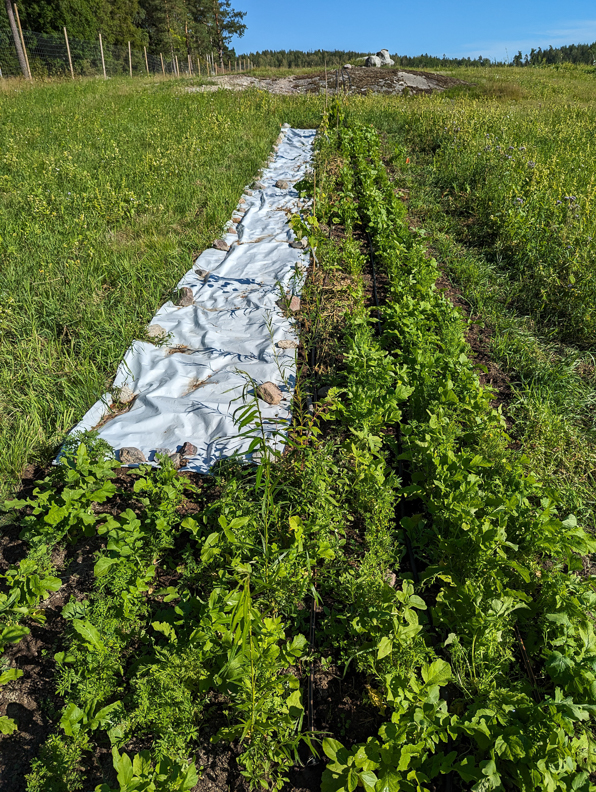 |
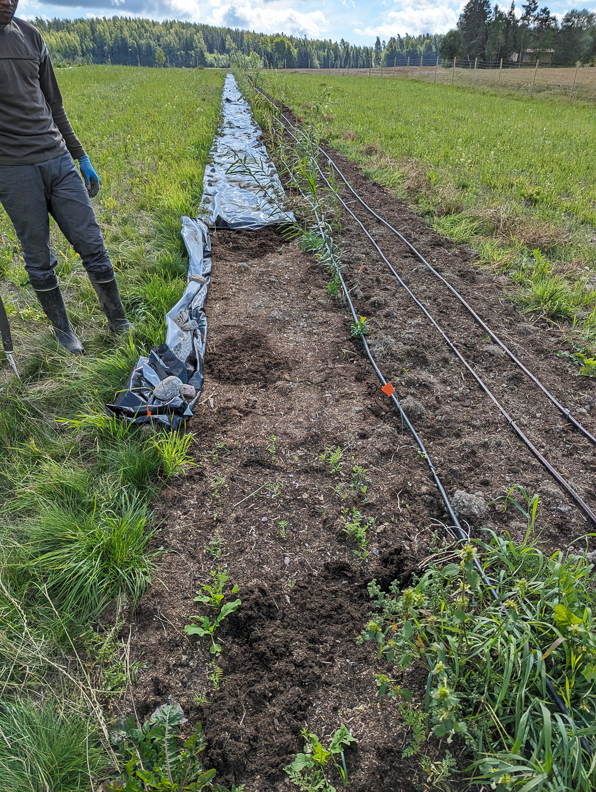 |
Location: #TreeLines
Theme: #Observation, #CoverCrop
Observation: Summer Invertebrates
An indication that plant biodiversity was beginning to attract other kinds of life can be showcased through the diversity of invertebrates we observed during the summer. Caterpillars, aphids, ants, bees, hoverflies, spiders & molluscs of one kind or another have been seen in the field. Undoubtably we would rather see more bees and benign insects, but a simple fact of ecology is that you cannot have predators without prey. Our system is young, the soil is degraded, and therefore the health of the plants is suboptimal. In these conditions it should be taken as a matter of course that with this much biodiversity in plants we should also be seeing large numbers of pest species. Some of these, such as the Spanish slug, could pose significant challenges to production without using pesticides, but we will forgo the use of such inputs in favor of building plant immunity, creating habitat, and observing whether the complexity of the system will allow it to self regulate.
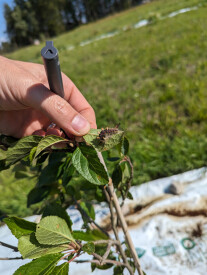 |
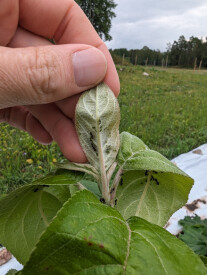 |
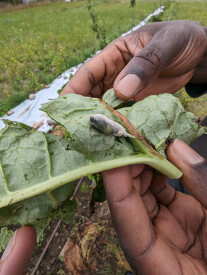 |
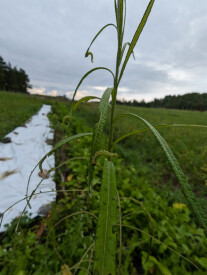 |
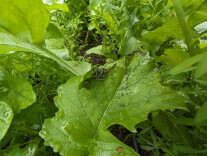 |
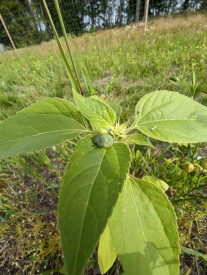 |
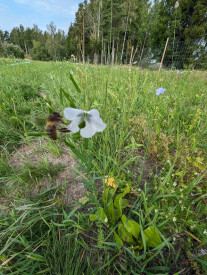 |
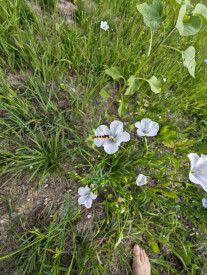 |
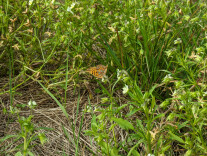 |
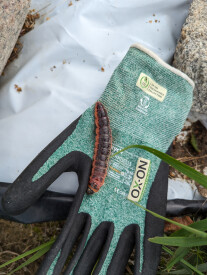 |
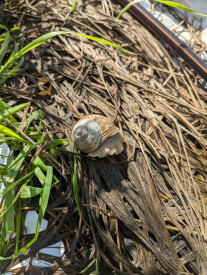 |
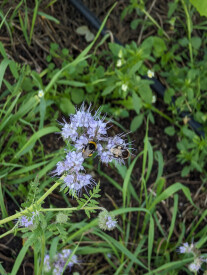 |
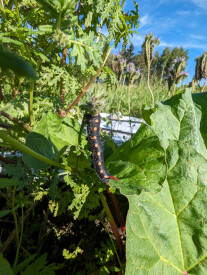 |
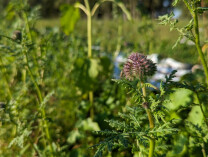 |
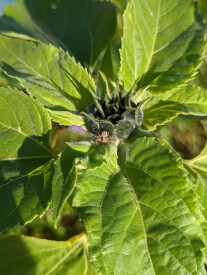 |
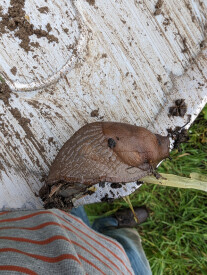 |
Location: #TreeLines, #Alleys, #Margins, #WholeSite
Theme: #Observation, #Invertebrates, #Biodiversity, #Pests
29.08.2023 Post Large Rain Events: ± 100 mm Precipitation
Excerpted and slightly modified from the Summer 2023 Report provided to the Steering Committee:
"By the middle of the month, the site had not only recovered its soil moisture, but we began to experience an intense rainfall period. Nearly every day for two weeks some precipitation was recorded at nearby weather stations. The heaviest precipitation was recorded between August 27th and August 31st. Over the course of five days, the following total precipitation was recorded:
● Espoo, Tapiola. Finnish Meteorological Institute (FMI). 16 km east of site: 87,4 mm
● Espoo, Nuuksio. FMI. 20 km north of site: 92,5 mm
● Kirkkonummi, Laajakallio. Private weather station (Wunderground ID IKIRKK32). 3 km
west of site: 96,64 mm
● Kirkkonummi, Gesterby. Private weather station (Wunderground ID IKIRKK41). 4 km
northwest of site: 116,91 mm
More locally, the Risto who farms and lives at Lill-Nägels, reported a total of 130 mm of rainfall over the weekend preceding Monday the 29th.
At the low end, the Tapiola measurements correspond to about 13% of the total average annual precipitation for Helsinki. At the high end, Risto’s account brings the amount of rainfall during this short period up to 20% of the average.
Not surprisingly the fields and streams around the site filled to capacity. The surface erosion brought with it plenty of sediment and the high clay content of the soil meant a clear high water line was evident not only by the bent stems of plants in the stream's ditch, but also by the clay left behind on the plants themselves. Even the farm pond which we draw irrigation water from spilled over, carving a new channel as water does."
What was surprising was that we only saw a few places with standing water two days after this, such as M3: the photo through the fence catches some of the highlights of sunlight reflecting from the ponding water. Otherwise, the site seems to have performed admirably despite the poor state of health.
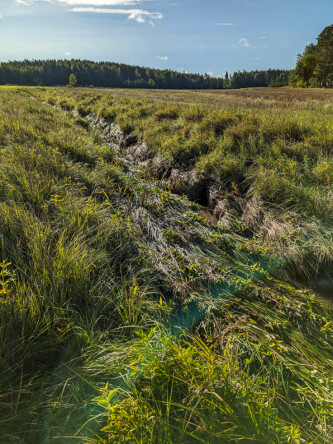 |
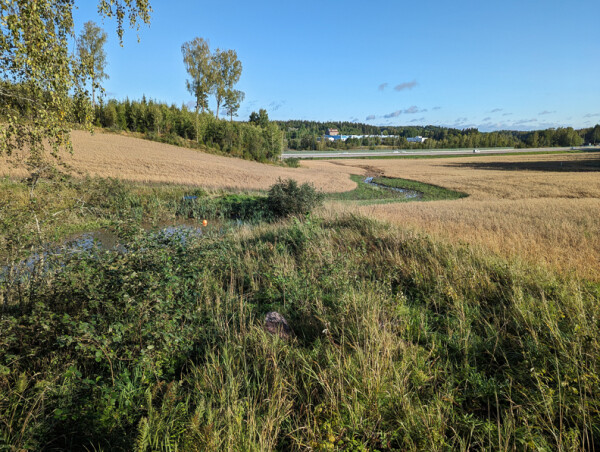 |
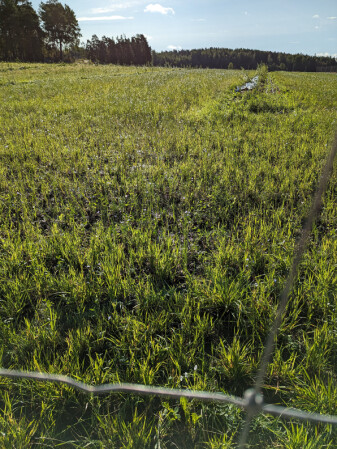 |
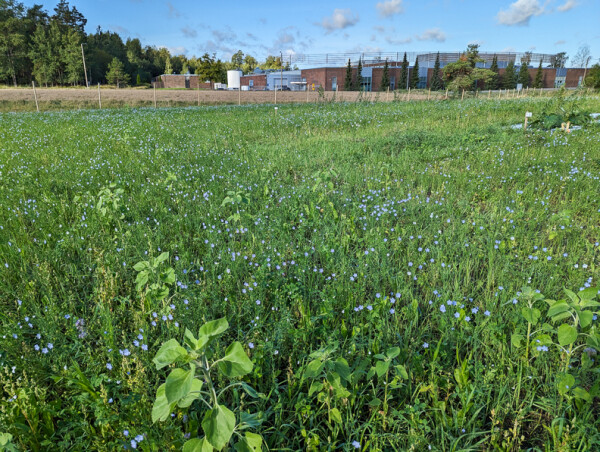 |
Location: #TreeLines, #Alleys, #Margins, #WholeSite
Theme: #Observation, #Climate, #Weather
Late September: Summer coming to a close
Growth began to slow in September, though given the full-sun aspect to this project site we still saw some good growth. T4 was coming into its own, although the heavy rains seem to have affected the cover crop. The plants were more stunted than elsewhere and had less vigor overall. Nevertheless, we have to start somewhere. One thing you'll see, despite the poor rendering of the photos, is how dark green the grass on the edge of the bed is. The edges of the beds were mown with a scythe a few times during the summer and I find it interesting that this darker green color was evident in many photographs.
Also by this point, we had sent in sap analysis rather regularly since July and had started to get a picture that we were lacking in some key micronutrients. Rikard Korkman (pictured below, left, with Florentine on the right) offered some of the micronutrients he had on hand. We added a tiny portion (5 ml) of a boron solution and 50 ml of a mix by Yara of calcium, zinc, and boron to the usual combination of seaweed & compost extracts, plus some left over lactic acid bacteria. This we sprayed on the plants in the tree lines to supplement their growth into the final four weeks before we enter the so-called "Persephone Period." The Persephone Period is a term coined by an American organic vegetable farmer, Eliot Coleman known for his "Four Season Farm." Taking a page from Greek mythology, he was known to make special note of the period when total potential daylight drops below 10 hours. Once you reach this threshold, many plants- especially vegetables- no longer have enough energy to continue growing and effectively come to a standstill. In our part of the world, this comes relatively early in mid-October.
Finally, more than 80 currants (black, red and white) arrived as bare root stock on September 19th. These would be heeled into the soil and planted out as their positions in the landscape were prepared with slightly less digging than before- just the removal of the top soil layer rather than both the top and the second shovel full for more traditional double digging.
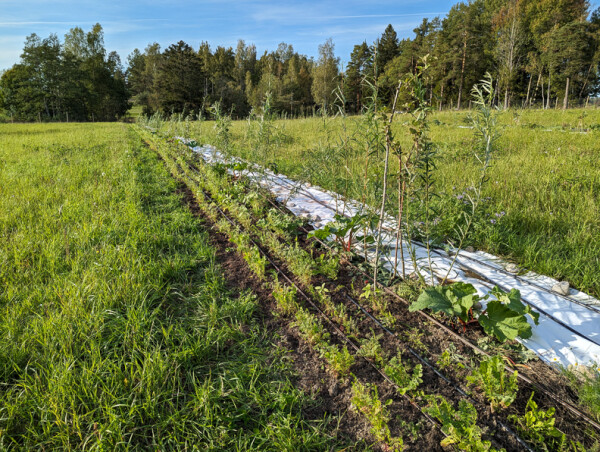 |
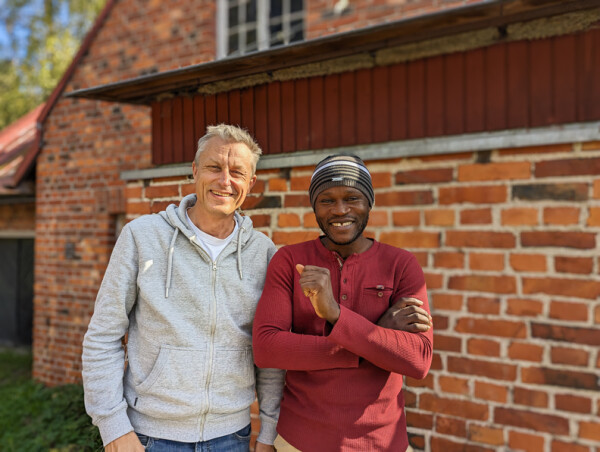 |
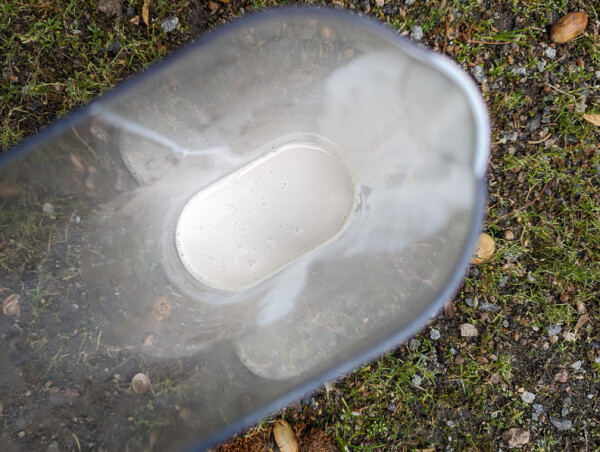 |
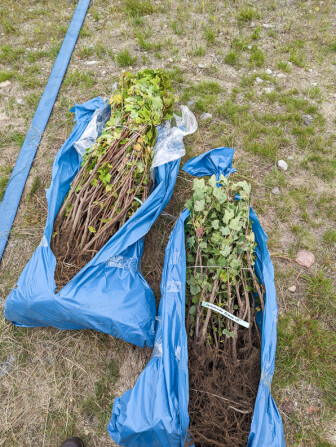 |
Location: #TreeLines, #Alleys, #Margins, #WholeSite
Theme: #Observation, #Biostimulant, #Weather, #Foliar, #FoliarFeeding, #CashCrop
October 2023: Garlic Prep and Planting
Once the currants were planted, it was time to begin preparing the east side of the tree lines for planting our second crop of garlic. A section of silage tarp would be removed at a time, then, using a broad fork, I would loosen the soil in two directions, then pull rhizomes from the beds. With the heavy fork and a little technique, it was possible to remove most of the rhizomes without inverting the mulch layer- a critical component of keeping the soil covered and fostering healthy soil development. The long tines of a broad fork are just long enough to start getting down to the plow pan at 20-25cm deep and did a remarkable job loosening the soil- which, despite being characterized here as either clay-loam or sand-loam, is still mostly loam. Which, when compacted, is very dense and doesn't allow for biology to grow well. Given that these sections of the tree lines had been subjected to silage tarps since June, we did not even have the chance to let diverse roots make their way into the soil and begin biologically loosening it. With that in mind, the decision to do the labor- bringing techniques from the intensive market gardening side of the project into play- would give the next year's garlic a stronger boost than before. In addition, the removal of the rhizomes would mean that weeding next year and in subsequent years would be more straightforward.
There are times when looking at the work as an investment into the next few years is worth it. Couch grass is not the friend of trees and in project plan we may not be able to grow enough mulch to totally smother it around the trees. As mentioned elsewhere, be aware that the alternative choices was already updated before the 2023 season to reflect the need on a working farm to prepare the tree lines further in advance to eliminate most of this kind of work (Step 3). With larger pieces of occultation plastic and at least one full year in advance, the grass would have been almost no challenge at all.
Tree lines 4, 3, and 2 were prepared this way to make way for 34,39 kg of organic planting garlic- 'Ljubasha' cultivar.
Upon planting, I also took the time to stop and start the clock with each and every bag of seed so that I could get a really fine fix on the amount of time to plant after preparing this way. This stopping and starting to inoculate each bag of seed garlic took its toll on the final efficiency of course, but it offers a strong base line for calculating costs for this kind of early succession cropping. The garlic was coated with a mix of compost slurries, seaweed extract, and endomycorrhizal fungi spores. When planting, I also took the extra effort to plant (all) of the cloves in the same direction, that is, with the round side facing to my left as I moved north along the row. This should see the leaves emerging in the same direction, aiding the mechanical weeding next year. Another thing that was different was that I did not use the planting frame except for on a few rows: I brought my market garden "gridder" to set the spacing and this sped things up too, especially since the soil was so loose from broad forking.
Thirty-six kilograms of garlic was significantly less than last years forty-six kilograms (36 is 78% of 46), so I adjusted the planting density to allow for the different size classes to have both 200 and 100 clove per 10 meter spacings so that the drip irrigation would be watering garlic along as much of the east side of the beds as possible in 2024.
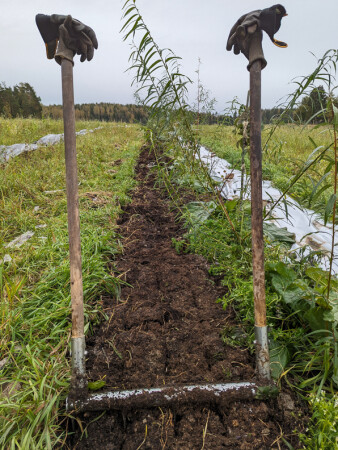 |
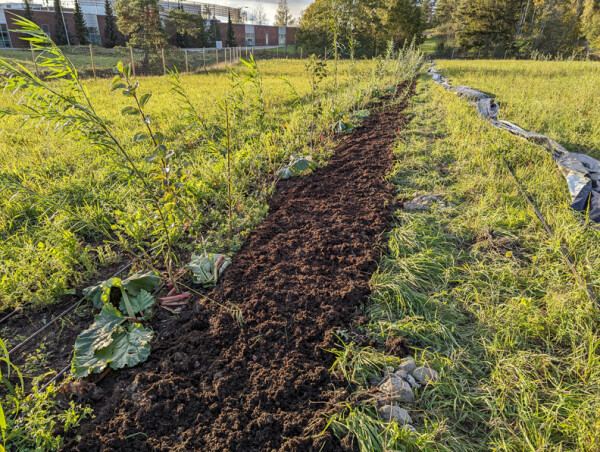 |
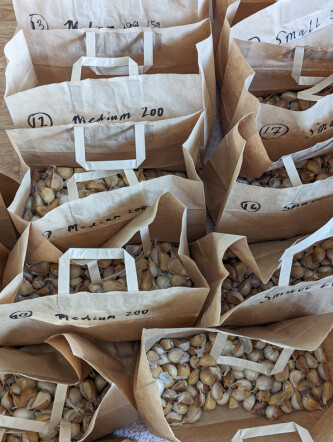 |
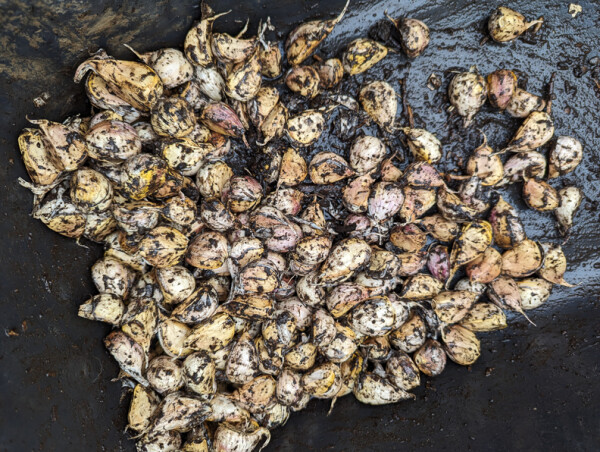 |
Location: #TreeLines
Theme: #Biostimulant, #Planting, #CashCrop, #BedPreparation, #Weeding
Late October - 07.11.2023: A Gift & Closing for the Season
Although not part of the project goal itself, as this is not exactly measurable, I have my own personal goal to co-create places that I want to be. That means investing in things that don't always have a measurable return, such as spring ephemeral flowers: tulips, daffodils, these kinds of "ornamental" plants. While there has been some research done in the past on the role that these kinds of species play in their environment, we don't have any data to support the hypothesis that these particular species are doing the same thing. However, the potential for early spring flowering plants to begin photosynthesizing, utilizing mobile nutrients such as nitrogen, and returning those nutrients in a more complex form for use by other organisms later in the year is one that has at least some possibility of being true. Much of this project is about finding interesting suggestions from scientific literature and seeing if we can arrange elements in a similar fashion to gain similar outcomes. If we wait for the research to support everything, then by definition we are not advancing but following.
Even if this is not the case, it is my experience that having beautiful flowers around you in the spring when things are just getting started improves the mood. Insects and pollinators will also be attracted early on to the field and begin communicating our site as a source of food to their nests. So I invested in a few mixes of certified organic flowering bulbs from the Netherlands and gifted them to the project. In addition, they had some organic saffron corms as well, which I purchased and planted in T2's sand-loam section. Saffron is hardy to about one growing zone south of us in southern Finland, but with the right microclimate, good planting depth, and mulch, it is possible that they can survive here. I don't expect the saffron to be an economic crop, but as an autumn flowering species it could prove interesting for our project. And if we get some local saffron to boot, why, that's just a bonus. One of these photos shows that, despite my efforts to keep all the bulbs dormant, they decided to flower anyway after planting.
I took the last soil samples and have included a photograph of some of the topsoil from T2's western side where cover crops had been growing for much of the late summer. We can see roots crossing this 6-centimeter clod of soil and perhaps the beginning of aggregation. There is a long, long way to go here but that's what we are here for.
Then, at the end of the first week of November, I added flexible rodent guards around all of the fruit trees and almost all of the currants. Some of the currants could not be guarded because they have too many stems, so if they survive the winter, when we prune them for the first time in 2024, we will ensure that the form allows for rodent protection. Now, it is certainly possible that our system will attract burrowing rodents which can girdle the trees underground as well. However, as you saw early in establishment, I did not add wire cages around the roots. Not only would this effort been nearly impossible to do alone in time, but it was a risk we chose to run.
Protecting all the trees and shrubs from rodents (and deer) is one of the realities of having very long winters when there isn't much else for the animals to eat. We'll see if the trees pass the most at-risk period of their life- the next 3-5 years or so- and act accordingly if we start to see problems.
But I don't want to end 2023's growing season on a note of potential despair at furry creatures killing all of our trees while they lay dormant for winter. I'd rather hope that most of our site makes it through the winter, that the rodents feast on some willows rather than fruit trees, and that, come spring, we will see not only garlic poking up in orderly fashion but also hundreds upon hundreds of flowers greeting the second growing season at Lill-Nägels!
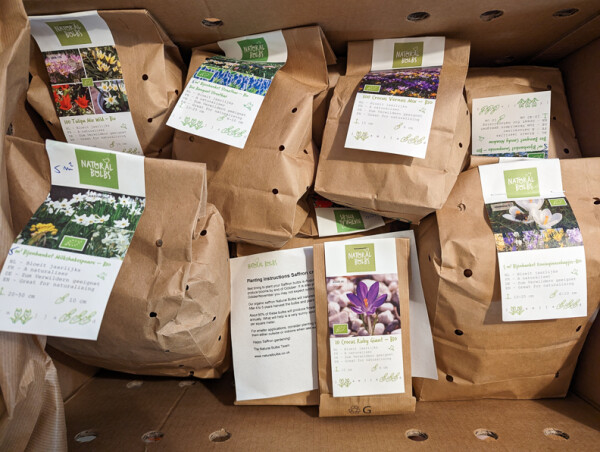 |
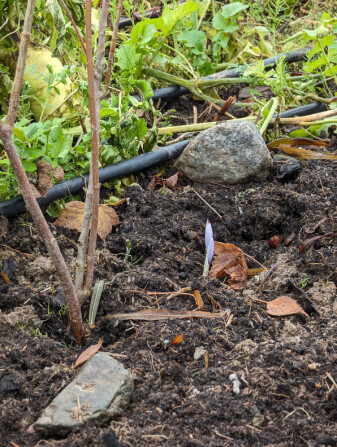 |
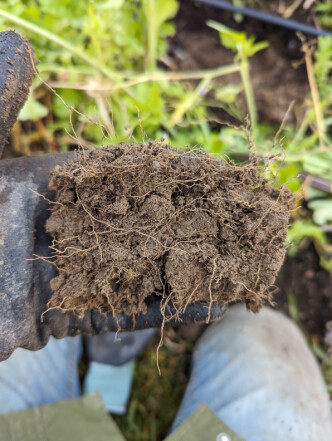 |
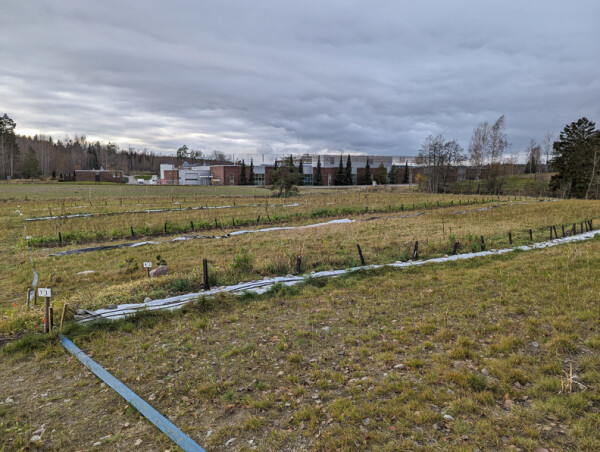 |
Location: #TreeLines
Theme: #Planting, #Biodiversity, #Analysis, #Infrastructure
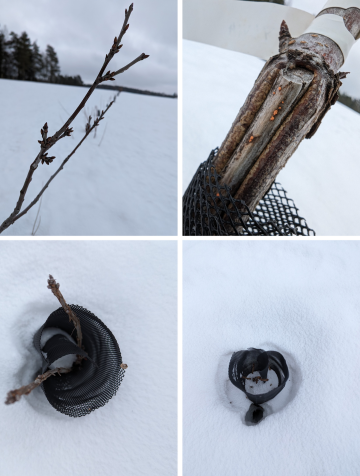
21.02.2024 Winter Visit
My first visit to the site in 2024 was in late February. Winter had arrived early with plenty of snow cover. I wanted to check to see whether any deer had hopped the fence and if there were any obvious signs of other animals eating trees.
Fortunately, despite the potential for deer to make it over the fence with so much snow, there were zero signs of any animals coming in through the perimeter fence.
I also didn't see, at the time, any obviously dead fruit trees or bushes- although the grapes did not look so very promising. Some plants had evidence of burrowing nearby with tunnels left by rodents coming up through the snow, although there aren't any track marks.
Sadly, some of the second class plants are infected with what appears to be Nectria cinnabarina, a common pathogenic fungus that usually indicates weak plants. In this image we can see how an older cherry tree is infected; the pathogen will continue to eat away at the dead wood in the center of the tree. Likely, the tree will not survive. There are also a few currants with the same disease on site. In those cases it is easy enough to prune away a dead branch and dispose of the infected material. In this case, it is the trunk.
Location: #WholeField, #TreeLines
Theme: #Observation, #CashCrop
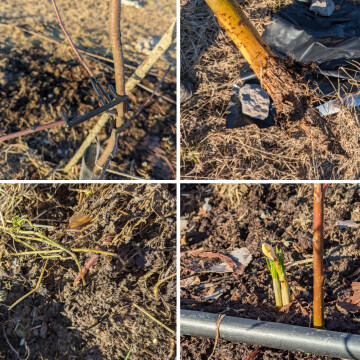
30.03.2024 Late Winter Follow-Up
Curious to see whether a week's worth of dry weather led to improved soil conditions, I optimistically visited the site with a bag of branch trainers in hand in the hopes of doing more than looking. I also brought with me a few printed site plans to put any important remarks down to the exact tree. I was relieved to see that the water had receded around all of the trees and was now standing only in the lower margins (M1-3).
After a round of observation and note taking, I found that the rodents had been busy working through some more willows and that some of the weaker currants may not have pulled through the winter.
Tree Line 2 (T2) was continuing to take the lead in growth: not only the saffron but spring flowering crocuses were in starting to bloom as well. Disturbing some of the mulch from last year I even saw earthworms foraging, which is a welcome sight for a location that has had very little actual observations of earthworms since the start.
I closed the day out by trialing the branch spreaders on those few fruit trees which are old enough to accommodate them as well as locking a few around currants to see if they'd be of service getting their architecture going. Currants will need a bit more work as they were delivered much older than any of the fruit trees and have a large number of stems. In the long run we'll likely have just 5 or 6 scaffolds per bush.
In a typical year, late March is still very early to tell much about the impact of winter on garlic and other over wintered crops, so I wasn't too focused on the lack of shoots.
Location: #WholeField, #TreeLines, #Margins, #Alleys
Theme: #Observation, #CashCrop, #TreeTraining
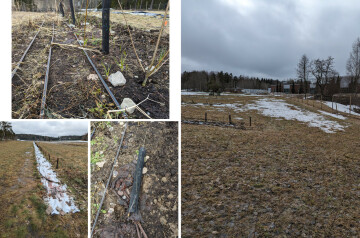
23.03.2024 Late Winter Visit
One month later the snow had begun to melt (although, in retrospect, this was not anywhere near the end of winter!) and much more valuable observations could be made than the peace of mind walk from February.
The southwest aspect of this site means that, if we have warm weather and sunshine, snow melts fast.
Being present in the fields at this time is really important for making observations that will simply not be possible if one waits.
The margins were still quite wet and even in some places water was standing around the trees. In the image on the bottom right, you can see how water has been trapped by Tree Line 1 Long (T1l). In an ideal situation I wouldn't see any standing water, but one needs to also consider that the soil is still completely frozen. Frozen compacted, poorly aggregated soil is far from ideal. Even frozen healthy soil may have standing water- so the duration of that pooling can tell you quite a bit about whether the water cycle is functioning to a high degree or not.
I had to remind myself that there had been a lot of snow and a fair bit of precipitation recently as well, so I made a promise to visit again a week later to see how things had changed.
What else did I notice? Well, I could readily see that rodents had been busy. They seem to have ignored the currants completely and I only found one fruit tree, a pear, that had been gnawed through underground. Likewise there were some willows that were severed completely and others had been damaged aboveground, some perhaps beyond saving. The damage was most apparent in Tree Line 3 (T3) because of the plastic mulch on the west side of the bed providign shelter for rodents more than the other locations. The willows are of minimal concern given how easy it is to propagate more, but the fruit trees are the ones I feel more for.
As I've mentioned elsewhere, some folks consider it important to cage the root system as well as the trunk. This is an option but one we did not take: recall that I planted most of these trees alone and doing so is difficult enough, let alone adding the work of securing a metal cage around the roots. I'm a little skeptical of what it does to the root system as well given how tight the mesh needs to be to keep the rodents away and how that might affect the development of larger diameter roots.
In the future we will not have any plastic down over the winter at all in any place whatsoever, even for storage. The rodents just go crazy for it and even start to eat it.
On a less forbidding note, I was very pleased to see that the saffron I had planted last autumn was alive and well. Quite of a few of them had already emerged and more were on their way. Some spring ephemerals were also starting to poke through, along with the stronger rhubarb crowns.
Location: #WholeField, #Margins, #Alleys, #TreeLines
Theme: #Observation, #Pests
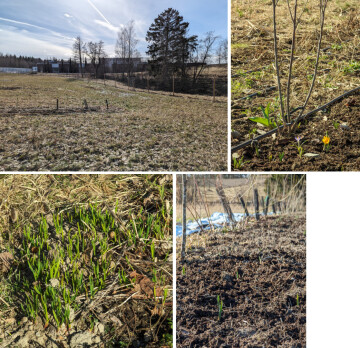
12.04.2024 Early Spring Visit
My next visit corresponded with, in hindsight, the start of a false spring. The year prior also saw a string of clear, warm days. Longer-term experience also suggests that the weather noticeably shifts towards growing conditions in April. Some years I have even been able to plant early spring crops in the middle of April with a light frost cover.
We had an unusually large amount of precipitation roll through ten days prior and the effects were still to be seen on the way to and within the site itself, again in the margins (first photograph shows where the snow had accumulated, was the last to melt, and was still standing in M3).
I had a few goals for the day: walk the site and note any early weed pressure on the garlic beds, prune and begin using the spreaders more systematically on the currants, and move the occultation plastic out of the alleys. I would return later in the evening and apply a "foliar" (more like a bark application) of seaweed extract, compost extract, willow water extract, and a calcium-zinc-boron blend of nutrients to support early leaf and budding in the trees.
I was able to make my observations and pull all of the occultation plastic out and dry it, but it took quite some time to do so alone with the wind picking up. I realized that my plan to return and apply some pre-bud-break nutrition to the trees was a poor one with the windy conditions and I'm glad in the end that I didn't do so because winter returned in full force less than a week later.
One thing that I found very interesting was how well the discarded very small garlic bulbs were doing up in the staging area (bottom left photograph). They almost look like microgreens. In the actual beds, T2 and T3 garlic were the most promising with T4 still lagging behind. My intuition is that this is simply the result of minute differences in microclimate: the lower number tree lines are higher in the landscape and have more pronounced solar gain with cold air drainage, while T4 sits near the bottom of the site, is the most flat, and had the most cold water sitting there during the first thaw.
Location: #WholeField, #TreeLines, #Margins, #Alleys
Theme: #Observation, #CashCrop, #Mulch, #Occultation

